Welcome to the Yodo1 Blog
Bringing you the latest news and updates from Yodo1, the mobile gaming industry, and work-from-anywhere culture
Game Growth
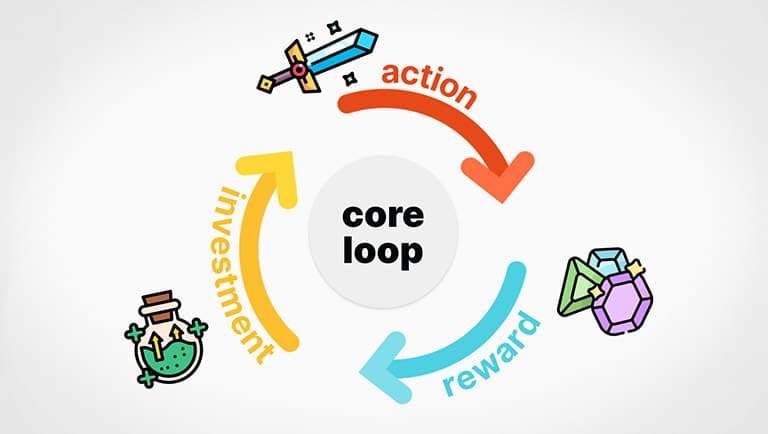
Expert Tips for Simplifying the Core Loop in Game Design
12.06.2024
•
5 mins read
Expert Tips for Simplifying the Core Loop in Game Design
Andrew Woodruff, Head of Product and Publishing | Yodo1 Games
Core loops in games are broken; there, I said it.
Most visualizations of gameplay shunt us through a tangled web of progression, actions, rewards, arbitrary features, and currencies that, let's be honest here, nobody fully understands. This complex spider web can hurt retention, limit revenue, and make life hard for everyone involved.
My math teacher in high school had the answer - KISS (‘Keep It Simple Stupid’). It’s time to hit reset and build a simple loop that aligns the whole team, from designer to artist to programmer, and keeps players deeply engaged, without all the tangled mess.
A Simple Core Loop
What is the core loop? It’s the set of actions the player takes to get rewards that can be reinvested. This forms the beating heart of your game! Think of it as an engagement engine, which, when properly built, is the driving force behind revenue and long-term retention. The most important takeaway is that a well-built core loop should be simple. Simplicity means no confusion and no misdirected motivations. Simplicity means a self-sustaining cycle, actually shaped like a loop, driven by your players’ desire to progress.
Simplicity is as critical on the development side as it is for players. Often, the “core loop”, when diagrammed out accurately, is a confusing tangle. How is a dev team, artist, investor, or stakeholder supposed to unify behind something that looks like a bramble bush? On the other hand, an oversimplified diagram can misrepresent the real picture, leading to further confusion.
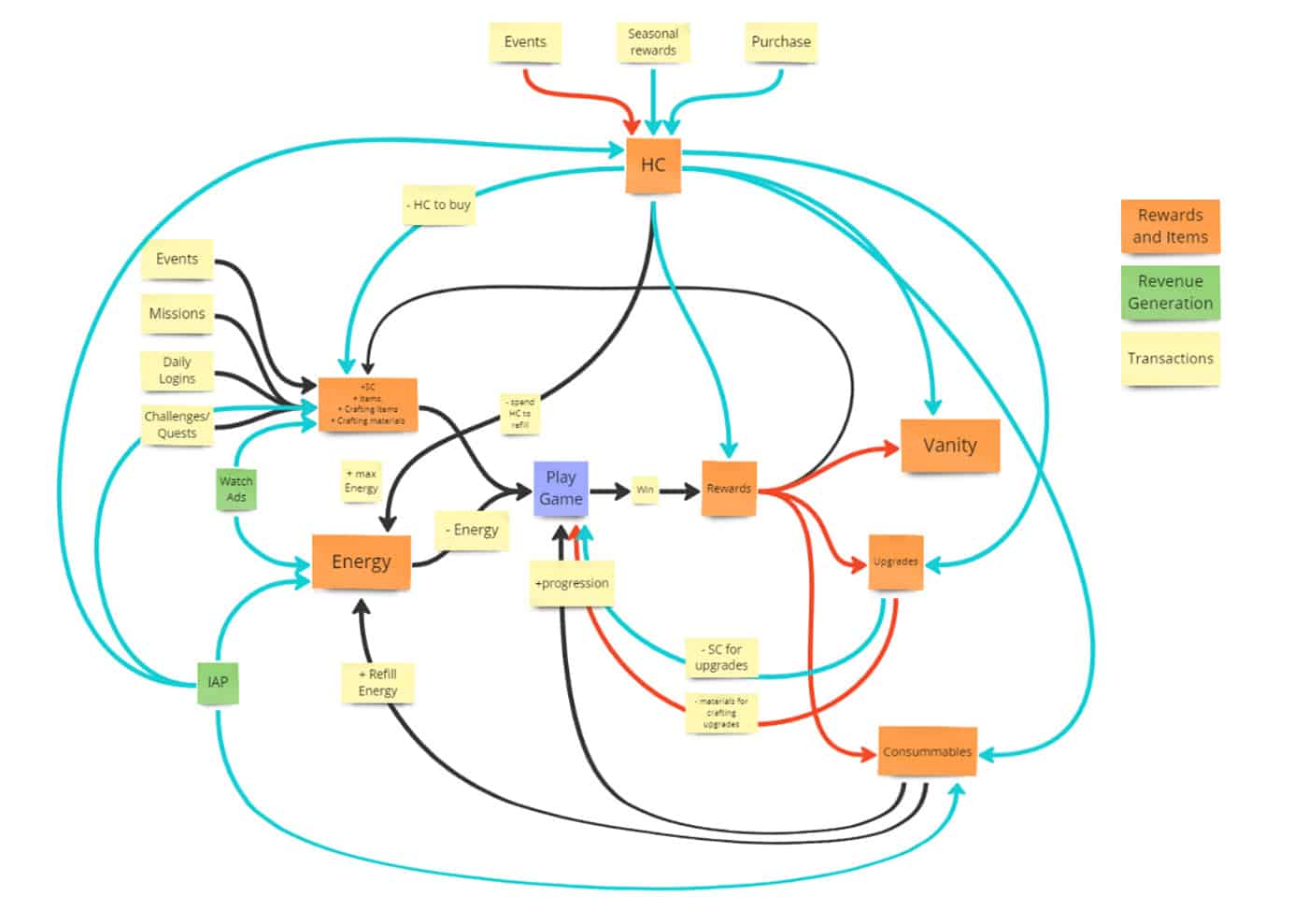
I propose we cut the Gordian Knot. Simplify the game’s core loop, full stop. As a result, everything (including the diagram) gets simpler. Devs understand what they are working on so players know what they are working toward.
Here’s the simplified core loop:
- Action: The player takes a meaningful action – completing a quest, crafting an item, defeating a boss, etc.
- Reward: They receive a reward that acknowledges their action. This could be tangible, like loot or experience points, or intangible, such as the satisfaction of overcoming a tough challenge or unlocking the next chapter of an amazing story.
- Investment: The reward is reinvested back into the game, giving the player new tools, abilities, or resources, enhancing their future gameplay.
This cycle creates a constant dynamic of motivation and gratification. Each reward instills the drive to reinvest, grow stronger, and perpetually work toward the next big thing. Build in a game economy that offers options for progressing more quickly, and you have all the tools in place for a world-class game.
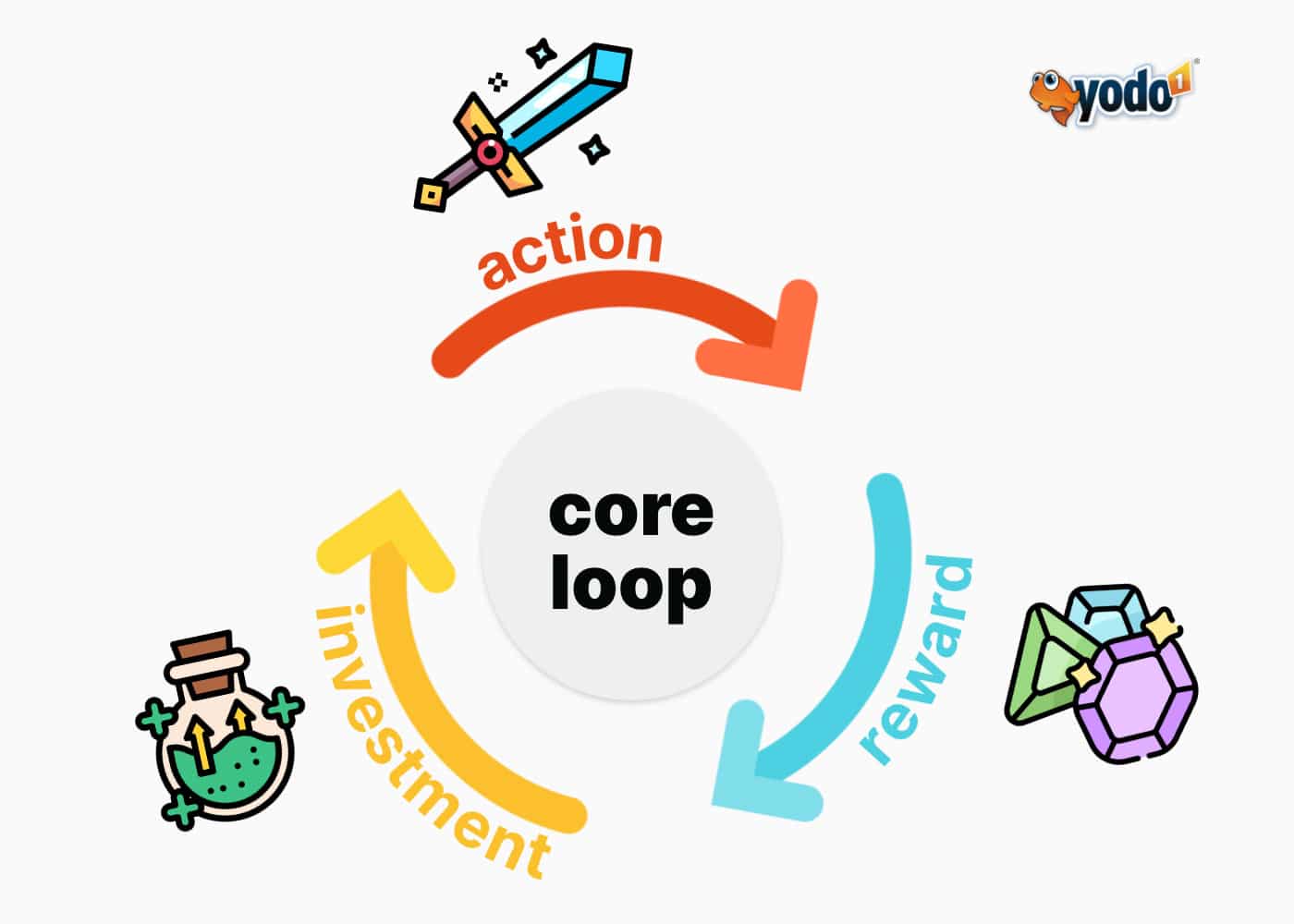
Fine-tuning the Core Loop Over Time
Simplicity is key, but the real magic happens when we balance the game properly. How? By perfect timing when players act, earn, and invest.
Early in the game, keep it simple. Let’s say that means one action gives one reward, which buys one upgrade. This teaches players the ropes without throwing them in the deep end too soon.
Early wins are easy and engaging, but as the game progresses, rewards should get tougher to earn. This may mean ten actions for one reward, effectively making each action worth just 0.1 of a reward. This scale-up, if tuned properly, keeps players engaged as their skills improve and makes those hard-earned rewards feel even more special.
Tuning the core loop should not be a guessing game. Use real gameplay data to strike the right balance. A/B test different action-reward ratios at various progression points, focusing on key metrics like player retention, LTV, IAP conversion rates, session length, and DAU.
Armed with such feedback loops, make ongoing adjustments, such as:
- Rebalancing overpowered or underbaked character abilities
- Tweaking resource economies and loot tables
- Re-tuning the difficulty curves of specific encounters
Tuning the core loop in real-time with actual player data ensures that players feel their time and efforts are well-invested, optimizing for engagement, retention, and ultimately, the game's financial success.
The Final Word
A well-designed core loop is simple yet dynamic, keeping players engaged and invested. When diagrammed, it should also be easy to avoid the tangled spider web and focus on creating a clear, motivating, and rewarding experience for your players. The result? Better retention, higher revenue, and happier players.
To recap what we’ve covered, here are some actionable takeaways to help you get the ball rolling:
- Build a clear, balanced core loop (action-reward-investment) that feels satisfying.
- Integrate monetization thoughtfully, making it feel like a natural part of the game.
- Monitor key metrics and gather player feedback to guide your decisions.
- Iterate constantly, tweaking difficulty, loot drops, and mechanics for optimal balance.
Get all these right, and you’ve got something truly special on your hands. But the journey will have just begun. Then you need to think about how to reach new players and scale your game globally. Check out Yodo1’s Game Growth Accelerator Program to learn how.
Author Bio:
Andrew Woodruff
Head of Product and Publishing at Yodo1 Games
With over 16 years of global experience across top-grossing titles, Andrew has brought his expertise to bear across free-to-play gaming models, game design and production, marketing, operations, and business development. His resume spans Gameloft, IGG, R2Games, Mechanist Games, and NetDragon.
Now, at Yodo1, Andrew brings his full-scope approach to hit games like Rodeo Stampede, Transformers: Earth Wars, and Ski Safari.
Latest Blog Posts
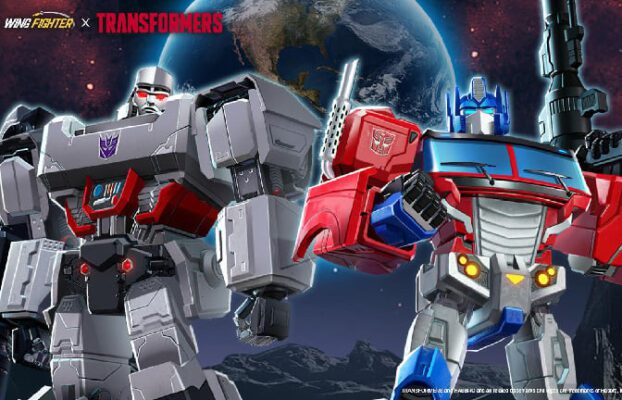
IP LicensingWing Fighter x TRANSFORMERS – A Battle for the Ages! January 6, 2025
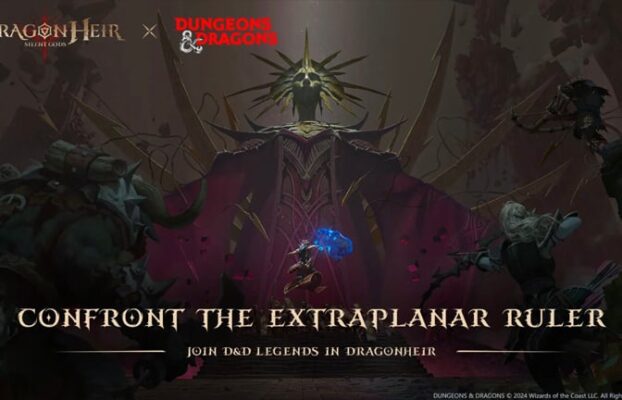
IP LicensingDragonheir: Silent Gods x Dungeons & Dragons – Enter the Third Phase of Epic Collaboration! December 20, 2024

IP LicensingTRANSFORMERS bots and Puzzles & Survival Game Unite to Combat a Massive Invasion! December 16, 2024

IP LicensingYodo1 Gathers China’s Top Mobile Gaming Leaders to Explore Global Brand Partnerships in 2025 December 9, 2024

IP LicensingViking Legends Unite in Viking Rise A Once-in-a-Lifetime Crossover! December 3, 2024

Game GrowthGrumpyface Studios announces Castle Doombad: Free to Slay is available now on iOS and Android devices November 27, 2024
Game Growth
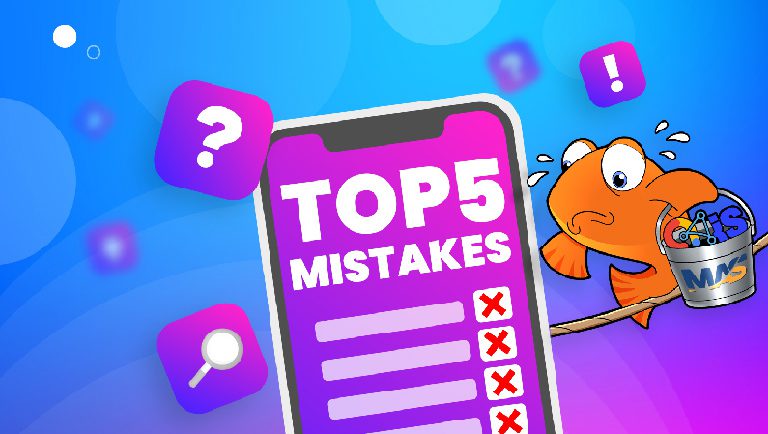
Top 5 Mistakes to Avoid in Your Creative/CRO Strategy
31.05.2024
•
5 mins read
Top 5 Mistakes to Avoid in Your Creative/CRO Strategy
Anna Frangogianni, Game Growth BD Manager | Yodo1
Table of Contents
- Unrepresentative Screenshots
- Geo-irrelevant Content
- Low-quality Screengrabs and Text
- Weak Icons
- Not Having a Solid Ratings and Review Strategy
In my earlier article on strategic ASO, I covered five key things to look out for during ASO metadata optimization. In this second part of the series, let’s look at five mistakes to avoid with your Conversion Rate Optimization (CRO) strategy, which focuses on the creatives used for the respective store pages.
You’ve spent so much time building a great game—doing justice to that impressive work means ensuring store visitors get a good taste even before downloading it. That’s why it’s so important to prioritize CRO and creatives.
Let’s explore five common mistakes to avoid, and how to tackle them.
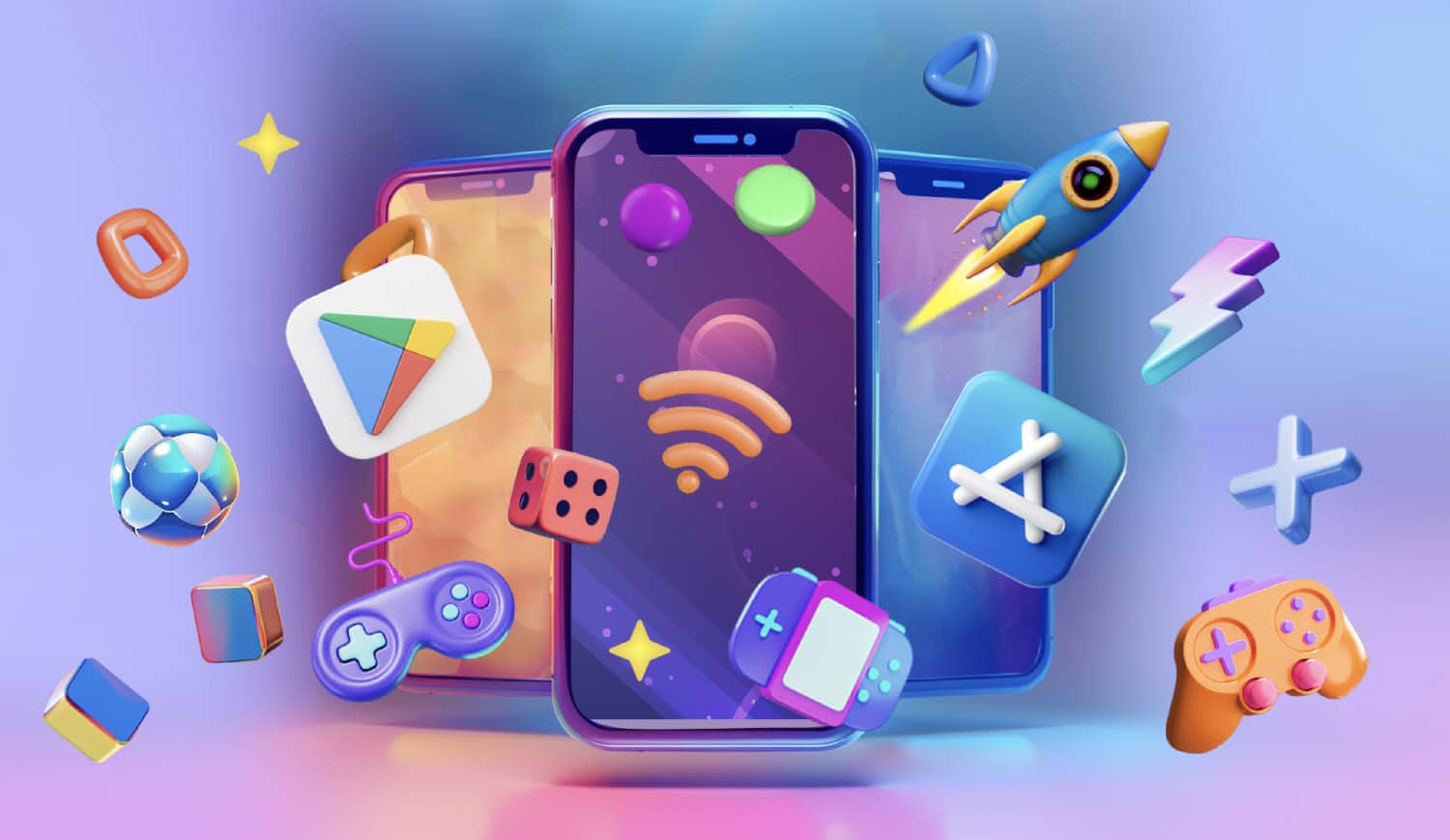
1. Unrepresentative Screenshots
The main purpose of your game’s screenshots is to grab a potential player’s attention. They should highlight both core gameplay features and storytelling elements. The goal is to communicate what makes your game unique.
Tip: While your first three or four screenshots tend to get the most views, this doesn’t mean some users won’t swipe through all of them. Test, test, and test until the content and order of your screenshots bring you the highest possible conversion rate. Yes, the order can make a difference.
2. Geo-irrelevant Content
Learn your audience's preferences and tailor screenshots to appeal to your target country or region visually. Research what kinds of screenshots popular games in your genre use in your target country. You’ll start seeing trends.
Tip: Studying player preferences, as well as what your competitors are doing, will give you a good baseline to understand how culturally localized, relevant, and appealing your screenshots are.
Example:
Notice that the screenshots from Roblox in the US Play Store are very clean and “simple” with a straightforward CTA (Call To Action) that highlights the game’s core features.
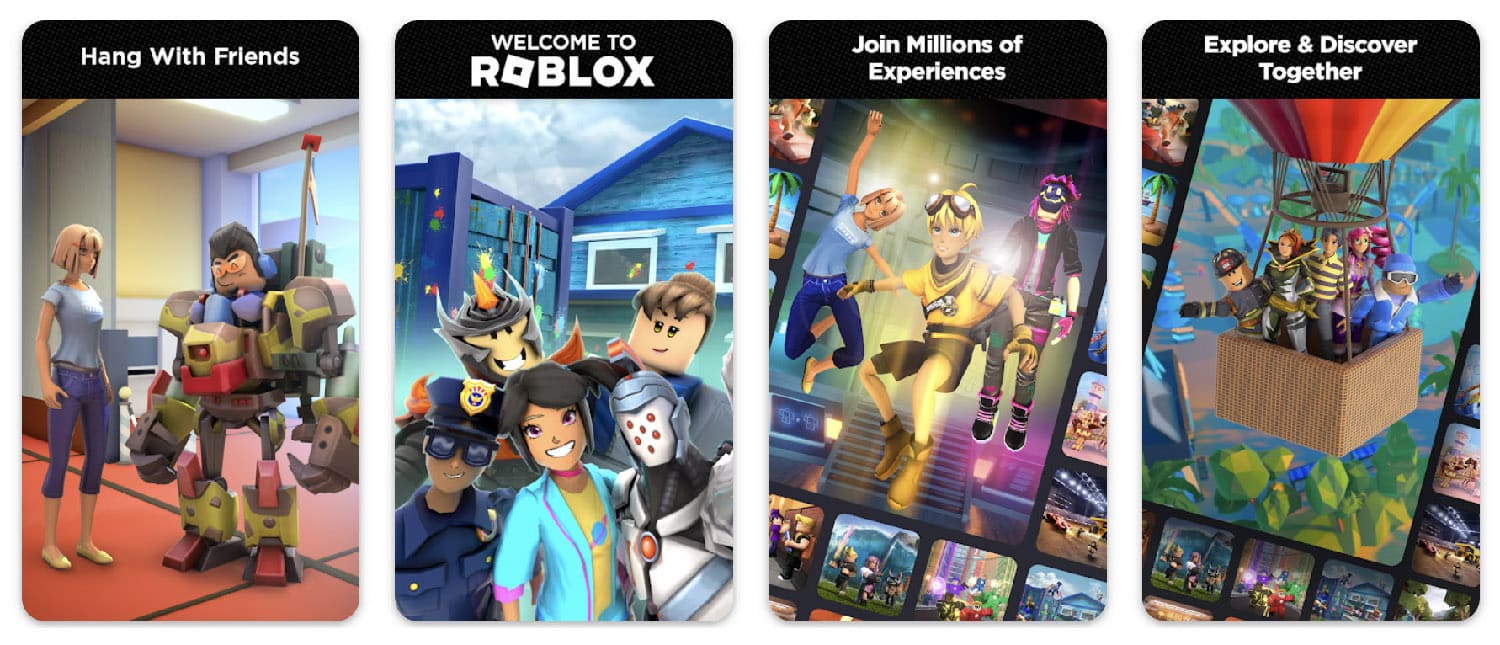
However, the style of the same game’s screenshots on the Japanese Play Store uses a lot more text and the layout is more complex, focused on highlighting many game features at the same time. The assets look “busier”.
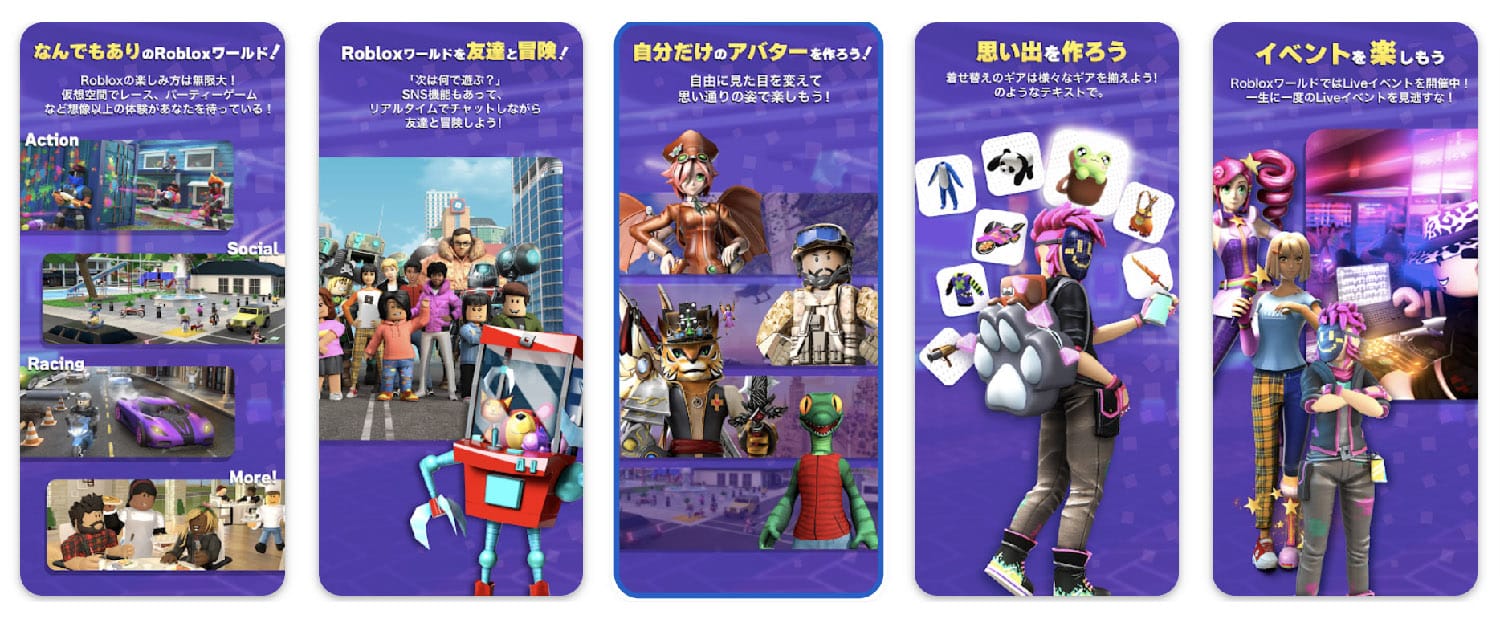
3. Low-quality Screenshots and Text
Your gameplay screenshots and storytelling elements should be crisp and clean—this is what potential players typically want to see. A blurry asset sends a “this is a low-quality game” message.
The same goes for text: your CTAs should be relevant to your metadata, clear, and readable. Most people looking for a new game to download spend just a few seconds looking at screenshots—and if the CTAs are not clear from the get-go, users will likely not spend time to try and find them in your screenshot.
Tip: When deciding on final creatives, put on your consumer goggles. Remember that everything you do sends a message. What is the message you’re sending with your creatives and how can your CTAs complement this message?
4. Weak Icons
Icons are the digital equivalent of an old-fashioned shop window display. It’s your potential audience’s first contact with your game; you need to make it count. Potential players should get a clear sense of what the game is about without being overloaded by visual clutter.
Your icon should match your game’s aesthetic. Players unconsciously base their expectations on the icon and will be disappointed if there is a mismatch. Another rule of thumb: avoid using text in your icon. The exception is when a game already has a strong, recognizable text-based logo, like FIFA.
Tip: Study popular game icons for common patterns. What icons do successful games in your genre use? Is there a common theme or structure? Apply the modeling (not copying) approach and test until you find a winner.
In these top puzzle games, note the general lack of people and brief intro to the gameplay, in the icons.

Yet, the opposite appears true in games similar to Idle Heroes.
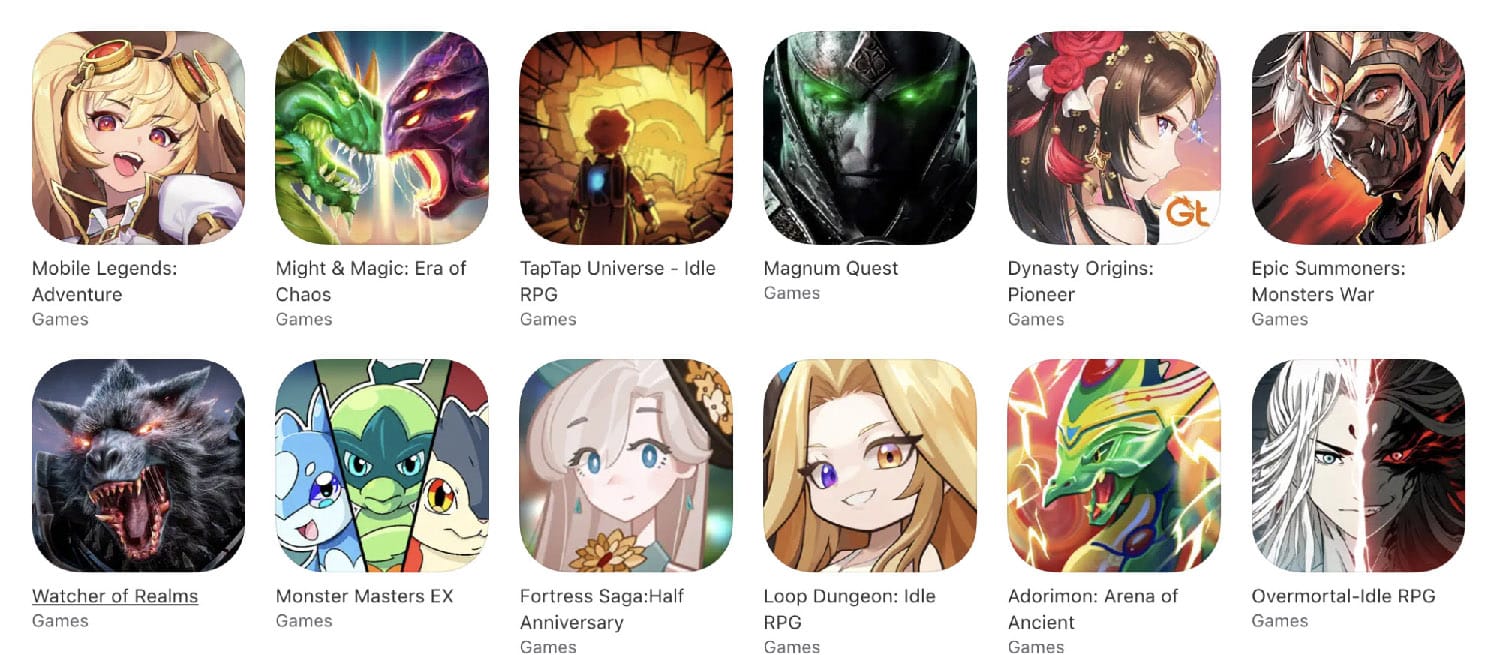
5. Not Having a Solid Ratings and Review Strategy
Having a strategy for ratings and reviews is essential, and you ignore it at your peril.
Your reviews are a great source of information for incoming players and an indicator of the customer service they can expect. When they see a history of thoughtful, responsive replies, users are more likely to download the game, so make sure to respond to reviews, both positive and negative.
Plus, a high volume of high-star ratings from players also triggers store algorithms to improve your game’s ranking and overall visibility. The more people enjoy your game, the more weight your keywords will have.
Tip: We know developers are busy people–tools like Fancraft leverage AI to make your ratings and review strategy painless and seamless, taking work off your plate.
Final Thoughts
If you’ve gone through this list and found areas where your game’s creative/CRO strategy falls short, it’s never too late to make positive changes. You also pave the way for a more effective user acquisition strategy by tackling these issues.
And if you’re launching a new game, do not cut corners on creatives. Putting in the effort to ensure quality, testing, and iteration is the only way to succeed.
Latest Blog Posts
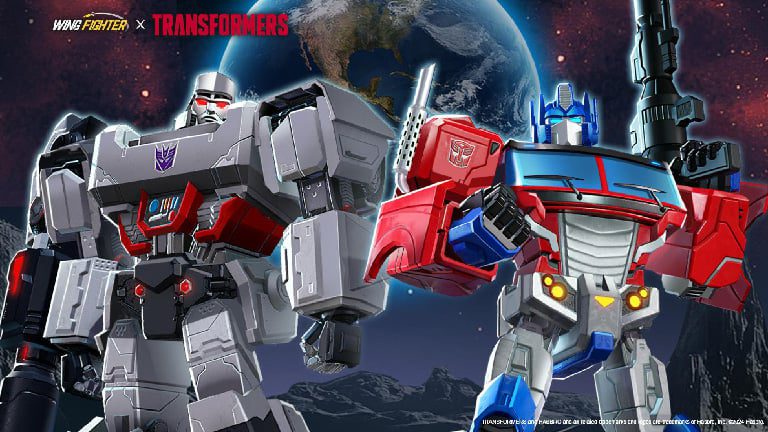

Wing Fighter x TRANSFORMERS – A Battle for the Ages!
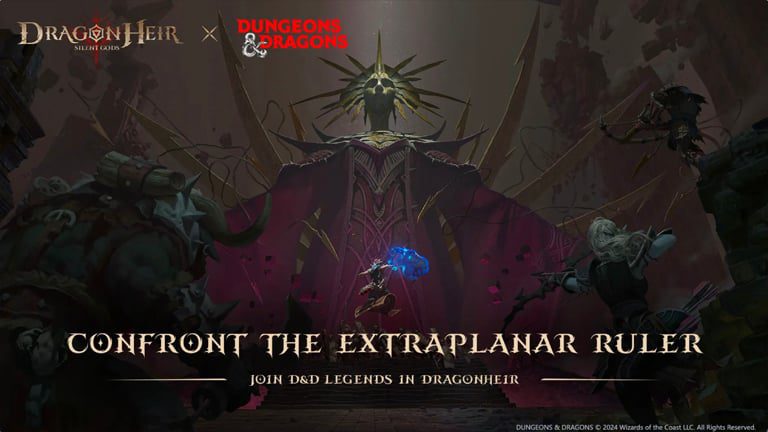

Dragonheir: Silent Gods x Dungeons & Dragons – Enter the Third Phase of Epic Collaboration!
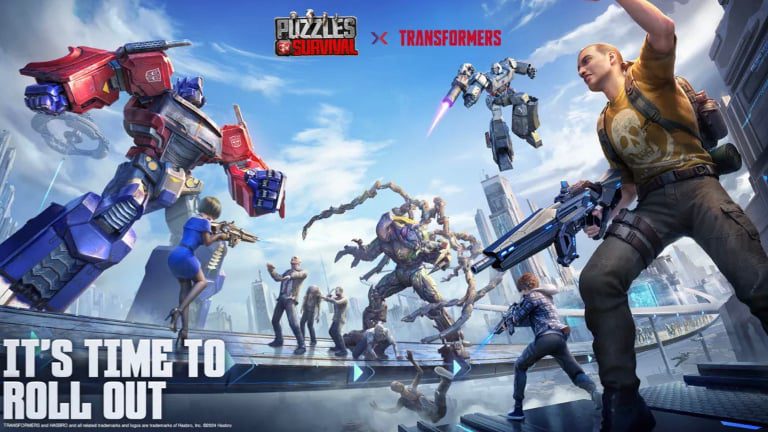

TRANSFORMERS bots and Puzzles & Survival Game Unite to Combat a Massive Invasion!


Yodo1 Gathers China’s Top Mobile Gaming Leaders to Explore Global Brand Partnerships in 2025


Viking Legends Unite in Viking Rise A Once-in-a-Lifetime Crossover!
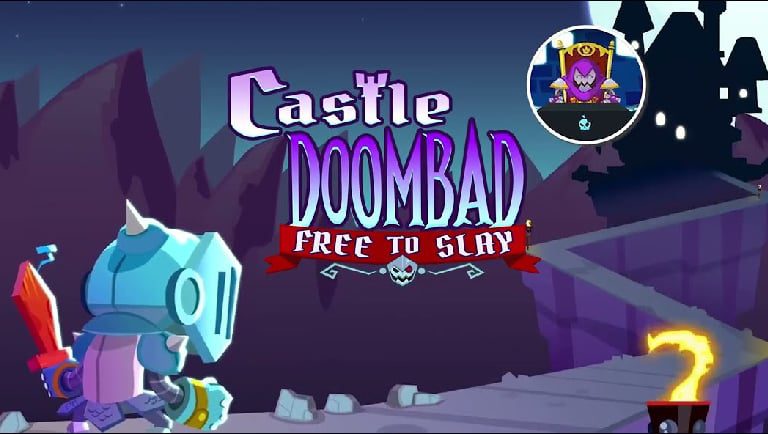

Grumpyface Studios announces Castle Doombad: Free to Slay is available now on iOS and Android devices
Game Growth
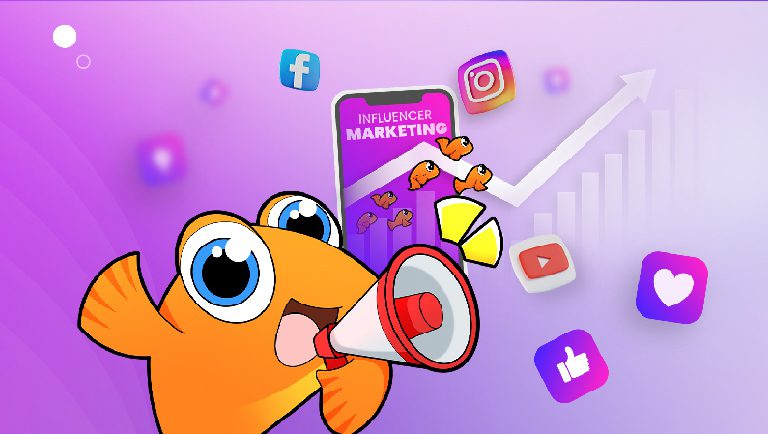
Influencer Marketing Has Matured… Now What?
22.05.2024
•
5 mins read
Influencer Marketing Has Matured… Now What?
Sandy Smith, Game Marketing Lead | Yodo1
Table of Contents
I get it – as game marketers and developers, we’re all fighting for those precious eyeballs and downloads. And sometimes marketing campaigns (i.e., traditional UA) can feel like dropping a pebble in the ocean…and an expensive pebble at that.

But influencer marketing? It’s a big opportunity! It has become an important pillar of marketing, and in 2024, influencer marketing is projected to become a $24 billion industry with gaming as the second largest sector.
Yet, there are nuances, and many questions:
- How do I avoid overpaying?
- Should I work with macro or micro-influencers, or both?
- Which platforms and formats work best?
- What about cultural differences?
Patience! All will be answered. Let’s dive in.
The Authenticity Factor
I've seen too many big-budget campaigns with huge influencers that completely flop. Why? Because if the creator doesn't genuinely love your game, their audience can tell. Genuine enthusiasm draws people in like gravity. Remember the time your friend couldn't stop raving about an amazing game they found? That's the kind of word-of-mouth magic you want to replicate. It’s the force that drove the massive success of Palworld in early 2024. Lightning in a bottle.
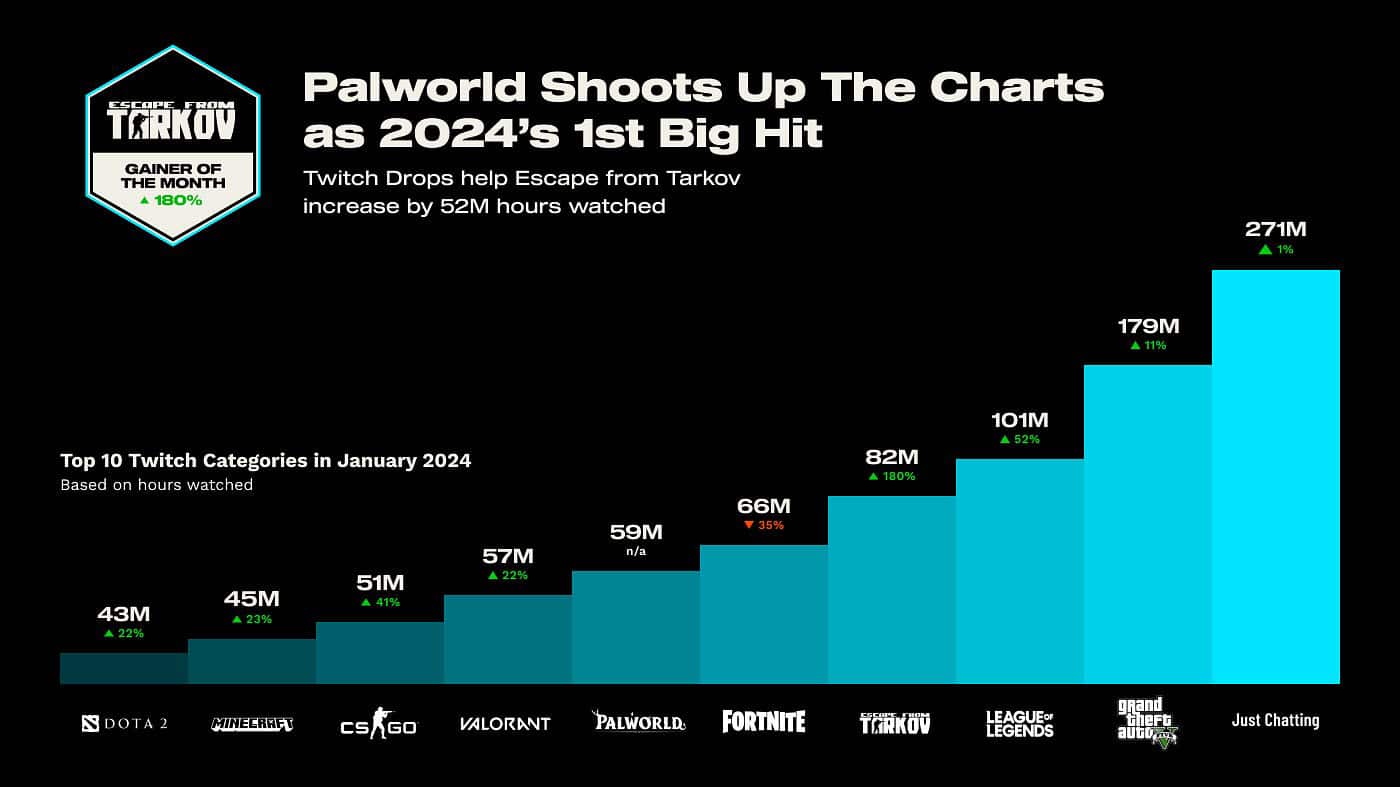
Via Streamelements
Finding Overlap
A massive following means nothing if the influencer's audience isn't the right fit for your game. It's like trying to sell Pokémon cards at a nursing home—not a good match. Dig deeper than surface-level follower counts. What genres and playstyles does a given influencer’s audience gravitate towards? Do their demographics overlap with your target players? Think of this as a Venn diagram, and do your homework on each influencer. Don’t just look at view counts. Look at engagement across an influencer’s content.
It’s also worth noting that many micro-influencers have dedicated, highly engaged audiences. Recent data shows that micro-influencers have up to 60% higher engagement rates compared to macro-influencers, making them a valuable asset in niche markets.
Tip: You can sometimes use an influencer’s previous paid content as a benchmark to decide if they will be a good fit. With videos, for example, look at the difference in likes and comments between sponsored content vs. non-sponsored content.
Putting It Into Practice
I work with a game called Idle Slayer, a seriously fun incremental platformer on mobile and Steam. Going in, we knew a one-size-fits-all global influencer strategy wouldn’t work. For example, the Japanese influencer scene is its own beast—creators like detailed scripts, and explicit directions, and tend to appreciate structure. Different, say, from how an American streamer may prefer to just wing it. Both can work, but you need to know why you’re doing things one way, rather than another.
In the case of the Japanese influencers, I also looked at how previous content with similar game mechanics and art styles had performed, as a proxy, and was very selective. Precision, as opposed to spray and pray. Also, doing my homework on the audience, likely outcome, and previous performance gave me a lot of clarity and negotiating power during the pricing discussions.
The Idle Slayer campaign in Japan resulted in a remarkable 3X spike in new installs over a single weekend, moving Japan from the 5th percentile to the 70th percentile in total installs! You can't argue with results like that. The takeaway here is to be strategic, to never get blinded by views alone, and to find the influencers who are going to love the game and want to share it–with passion.
https://www.youtube.com/embed/O4NWLfjgZ78?si=sQJLTNLE8luellOn
Tip: While there is no magic shortcut to avoid overspending on an influencer marketing campaign, the most important thing is to do your due diligence. Evaluate potential ROI, and establish a clear budget going into any negotiation. Research market rates, negotiate based on data, and look into performance-based compensation.
Diversifying Your Strategy
As a marketer, never sit still and assume you’ve finally figured it out. It can be easy to sink into a fixed way of thinking, but as soon as you do, you’re stuck in a status quo. Instead, develop a mindset of constant experimentation, constantly trying new things. This is also a fantastic way to diversify your influencer marketing strategy.
An example of such extermination may including something like seeding campaigns, which have emerged as a trending approach in response to the rising costs of traditional influencer marketing. The upside of these is that you’re generally working with micro-influencers, and offering them in-game benefits, rather than money. A big advantage is that it has a built-in authenticity mechanism. For an influencer to find your offer of in-game currency/items interesting, they need to actually enjoy the game. Otherwise, what you’re offering has no value.
I had a great conversation about this with Callan Saurma-Jeltsch on Behind the Game Podcast recently. Feel free to check it out.
https://www.youtube.com/embed/tFs6LRAXa2M?si=O12SbwoTA8wCad5s
While this approach is generally more time-consuming, it is a great way to round out your overall influencer marketing strategy, providing a hedge against a single big-budget influencer campaign that underperforms.
Again, the best way to get the most bang for your influencer marketing buck is to have more than one approach to lean on.
You Cannot Improve What You Don’t Measure
Track these crucial metrics to understand your campaigns' effectiveness:
- LTV (Lifetime Value): Focus on the long game. How much revenue do players generate over time?
- UAC (User Acquisition Cost): How much is each acquired player costing you?
- ROI (Return on Investment): Are you making more than you spend?
- Retention: A high install count is meaningless if players leave after a day. Analyze retention rates to uncover what truly resonates with your audience.
- Conversion Rate: While not always the end-all-be-all, tracking conversion rates for tracked links can help you iterate messaging and offers.
Collectively, these provide a comprehensive view of your campaign's performance, allowing you to adjust strategies and optimize results.
Toss the Playbook; Stay Scrappy
Influencer marketing is a fantastic tool, but the landscape is always changing. The key to success? Stay curious, experiment fearlessly, and measure everything. Always be ready to adapt your strategies and get creative. When you combine authenticity with audience overlap and sprinkle in some out-of-the-box thinking, you unlock the true benefits of influencer marketing for your game.
If you’re interested in game marketing conversations like these, check out the podcast, and let me know what other topics you would like to learn more about on LinkedIn!
Latest Blog Posts


Wing Fighter x TRANSFORMERS – A Battle for the Ages!


Dragonheir: Silent Gods x Dungeons & Dragons – Enter the Third Phase of Epic Collaboration!


TRANSFORMERS bots and Puzzles & Survival Game Unite to Combat a Massive Invasion!


Yodo1 Gathers China’s Top Mobile Gaming Leaders to Explore Global Brand Partnerships in 2025


Viking Legends Unite in Viking Rise A Once-in-a-Lifetime Crossover!


Grumpyface Studios announces Castle Doombad: Free to Slay is available now on iOS and Android devices
Game Growth
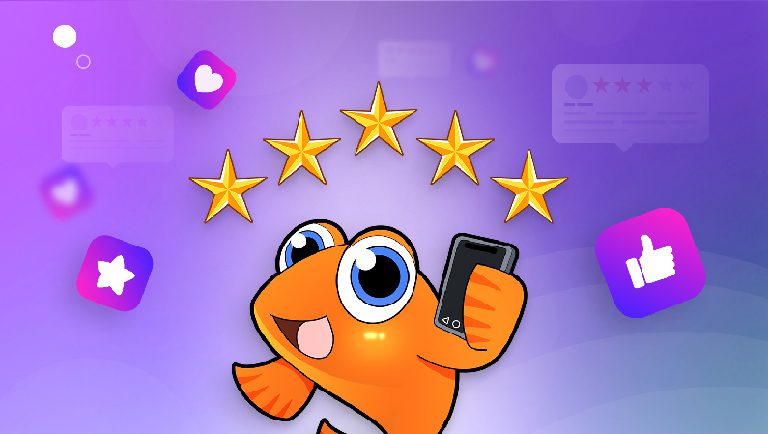
Reviews Are the Biggest Missed Opportunity for Game Growth–It’s Time to Change That
08.05.2024
•
5 mins read
Reviews Are the Biggest Missed Opportunity for Game Growth–It’s Time to Change That
Downloads and retention. If a game is going to be successful over the long term, it all comes down to downloads and retention. The next obvious conclusion for any game developer is to do whatever you can to increase downloads, and maximize retention.
But of course, it’s easier said than done…
Reviews play a key role in both. Good reviews make more players decide to download a game. On the other hand, bad reviews scare away potential players. Reviews are a very important factor in both the discoverability of your game in the app stores and the conversion rate. That’s a fact.
With retention, players often leave reviews because they want to be heard. One reason they may leave the game is that…well, they don’t feel the developer is listening, or cares. That is why responding to reviews is so important. It can have a big impact on retention, and turn bad reviews into good reviews.
The problem is that responding to reviews and engaging with players takes a lot of work. Community managers do it as a full-time job, after all!
At Yodo1, we get it. We live it every day with the games we publish. And with over 10 years of experience engaging over 3 billion players, we have become very good at it. But one day, we asked ourselves if there was a way to make responding to reviews and engaging with players less time-consuming, more scalable, and more efficient.
We decided that, yes, there was a way. We built it for our games, tested it extensively, and have now released it to the world. We call it FanCraft.

Reviews Made Easy
Knowing how important it is to respond to reviews, how does it feel to see them piling up because you have so many things on your plate and you just can’t fully catch up? It’s probably not a good feeling.
But remember, reviews can make or break the long-term success of your game. Responding to them can mean the difference between a highly profitable game, and a game that becomes a total flop. Discoverability. Downloads. Retention. These depend on you responding to reviews and engaging with your players!
This is where FanCraft comes in. FanCraft is a groundbreaking product developed in-house by Yodo1 and uses generative AI to make responding to reviews easy. FanCraft streamlines the management process, allowing developers and community managers to maintain a genuine connection with their players—effortlessly. Oh, and there is no SDK to download.
What You Can Do with FanCraft
Automate review replies: FanCraft analyzes reviews across various app stores and generates personalized replies that take seconds to approve. It allows you to stay connected with your players while saving work hours and ensuring no feedback goes unnoticed.
Turn 1-star reviews into 5-star reviews: Negative reviews are inevitable but they don't have to hurt your game. FanCraft recommends the best way to handle an unhappy player, giving you peace of mind at the push of a button.
Monitor player sentiment: FanCraft empowers you to find key areas for improvement across your community, then recommends steps based on Yodo1’s 10+ years of experience publishing hit games for billions of players. It means you can monitor your whole community in real time.
https://www.yodo1.com/wp-content/uploads/2024/03/Answer-Reviews-Quickly-FanCraft.mp4
On top of the main features, FanCraft:
- Provides valuable insights into player behavior, preferences, and demographics that can help inform future development decisions.
- Allows you to tailor replies to align with your game's tone and style, ensuring a consistent brand voice across all communication channels.
- Notifies you when new players leave new reviews, allowing you to engage in real-time.
Engage Your Community in Minutes, Not Hours
If you are feeling overwhelmed with all the reviews you haven’t responded to, knowing how critical it is to the long-term success of your game, it’s time to do something about it.
Your game’s reviews could be the biggest untapped resource you have. It’s time to give them the importance they deserve without all the blood, sweat, and tears.
Gain back countless hours of your precious time and join leading developers already leveraging cutting-edge AI to make deeper connections with their players and grow their games. Experience FanCraft today with a free trial.
Latest Blog Posts


Wing Fighter x TRANSFORMERS – A Battle for the Ages!


Dragonheir: Silent Gods x Dungeons & Dragons – Enter the Third Phase of Epic Collaboration!


TRANSFORMERS bots and Puzzles & Survival Game Unite to Combat a Massive Invasion!


Yodo1 Gathers China’s Top Mobile Gaming Leaders to Explore Global Brand Partnerships in 2025


Viking Legends Unite in Viking Rise A Once-in-a-Lifetime Crossover!


Grumpyface Studios announces Castle Doombad: Free to Slay is available now on iOS and Android devices
Game Growth
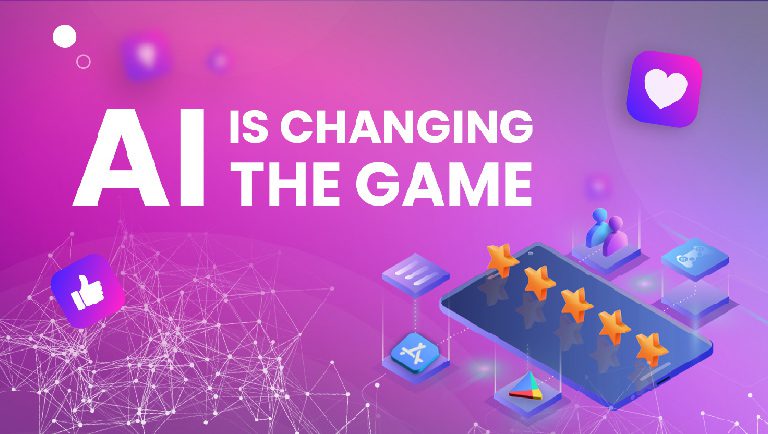
AI is Changing the Game
23.04.2024
•
5 mins read
AI is Changing the Game
While still in its early days, generative AI has already begun to change the gaming landscape. Today, that means early implementations of AI NPCs, procedural content generation, and a new era of tools for building and managing games and player communities, among other things. But this is only the first flush of a gaming future that's hard to fully wrap our heads around.
Yet, as exciting as limitless possibilities sound, they also present a whole new set of challenges to tackle. Let’s explore both edges of this particular sword.
The Future is Near
As generative AI capabilities accelerate, the frontiers of what's possible in gaming will expand exponentially. We're not just talking about dynamic narratives that adapt to player actions – the core gameplay mechanics and rules themselves could fluidly adapt and evolve based on player behaviors, and AI characters may soon improvise tactics and decisions that surprise even the developers. An early indication of this is AI NPC mods for games like Skyrim. Streamers CodeMiko and GingasVR make full use of such mods for their streams.
https://www.youtube.com/embed/cmCVyEgbp6o?si=Kjv0IVcIL6kUV1UV
Developers are using today’s AI tools to build assets and in-game experiences. While this must be recognized as a fraught issue in many creative communities, for justifiable reasons, the trend toward AI-generated games is difficult to deny, potentially moving gaming into a very different world where game developers set parameters, build narratives, and become curators for a nearly infinite set of player-driven experiences, much like the holodeck from Star Trek. As AI systems advance to become true creative collaborators with human designers, the meeting of machine intelligence and human creativity may bring about entirely new genres and gameplay concepts we can't yet imagine.
An interesting example of how AI can empower players in this way is the Roblox Assistant, which allows creators to quickly and simply bring their ideas to life.
https://www.youtube.com/embed/GHZZffgRvkw?si=W1Hbq_kkha-bw2A0
These developments could even realize the long-promised concept of the metaverse – massive virtual worlds that continue evolving autonomously with their own AI-driven communities, stories, and economies whether players are present or not. The boundaries of crafting transportive alternate realities will be blown wide open.
Yet while all this may seem exciting from the big-picture view, it’s important to consider the implications and potential challenges, which carry with them uncertainty and even fear of just how different the future could be. Which jobs and skill sets will be replaced in the coming years is an open question, and the copyright debate continues to rage.
At Yodo1, we think the best implementations of AI are those that make the existing and time-consuming work of game developers a lot easier, freeing them up to focus on being creative and making great games. We believe generative AI is at its best when it is minimizing the busy work, and maximizing the creative process.
Leveraging Generative AI to Engage Players
Developers, especially those in smaller teams or working solo, face the constant challenge of building and then managing their games, often wearing many hats, from marketing to customer support, community management, and more.
A key part of this work is engaging with your community—a critical yet time-consuming task. If your players feel that their voice is being heard, they are less likely to churn out of the game.
Enter FanCraft by Yodo1, an implementation of generative AI in the gaming industry that makes life definitively easier for even the most overwhelmed and overworked game developer. FanCraft responds naturally to player feedback, adapting over time to take on a voice that is unique to each game. FanCraft not only streamlines review management but also offers a way of engaging in a meaningful way with players, without the major time commitment, ensuring that each response feels personal and genuine, reflective of the developer's intent.
https://www.yodo1.com/wp-content/uploads/2024/04/Leveraging-Generative-AI-to-Engage-Players.mp4
By using FanCraft, developers can more effectively manage their workload, dedicating more energy to creative aspects of game development while maintaining robust communication with their players. It represents a step forward in how developers interact with their communities, offering them the freedom to focus on creative expansion without losing touch with their audience.
Navigating Uncharted Waters
We're entering an era where the boundaries of creativity and interaction are being redefined. The possibilities are as exciting as they are daunting.
At Yodo1, we believe that today’s AI is best used to enhance, not replace, the human element in game development. By streamlining repetitive tasks and fostering deeper player engagement through tools like FanCraft, we empower developers to focus on the creative aspects that truly matter—crafting unique, memorable experiences that resonate on a human level.
The human element is, and will remain, the essence of great games—human ingenuity and connection. Let’s move forward with a mindful approach to innovation, embracing the exciting possibilities of AI with an awareness of its impact on society and the industry alike.
Click the button below to learn more about FanCraft, by Yodo1.
Latest Blog Posts
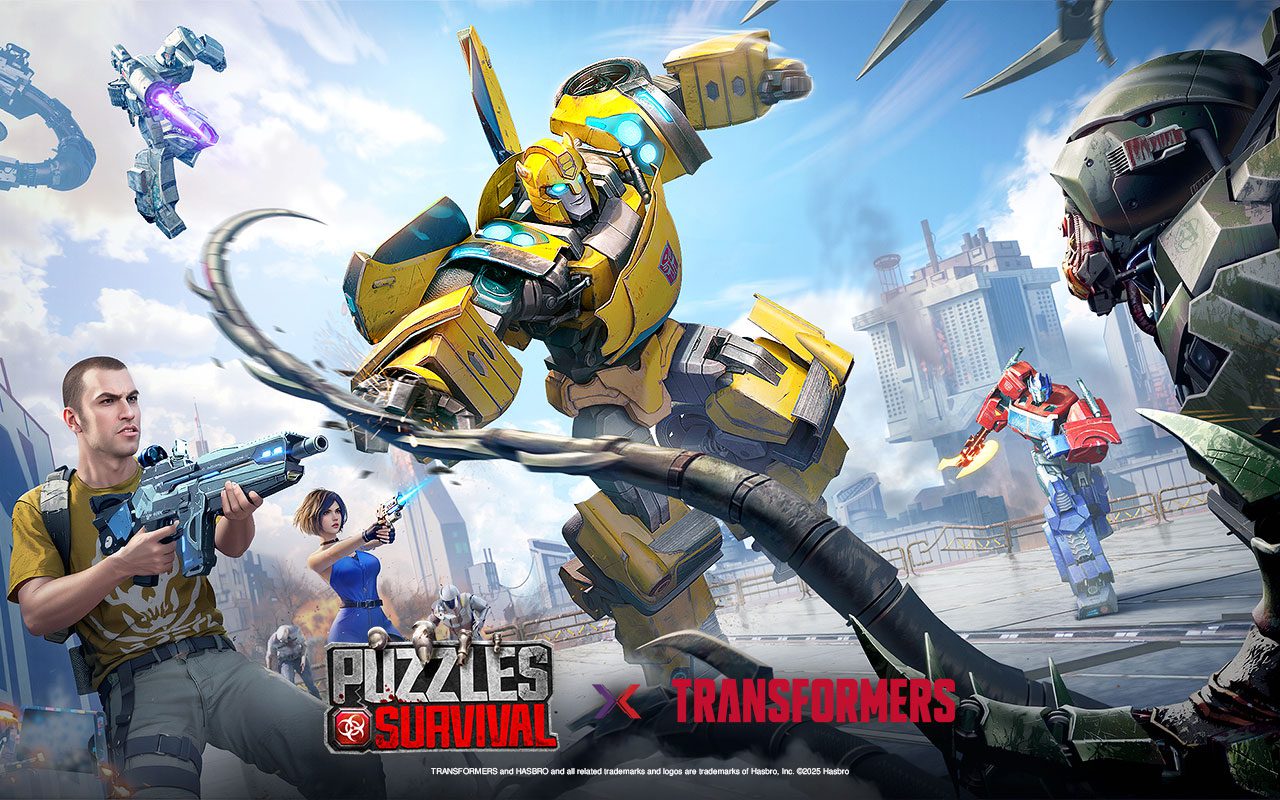

Bumblebee joins the battle for a second Puzzles & Survival x Transformers event


Viking Rise x Vikings: Valhalla Event 4 – The Grand Finale of an Epic IP Saga


Wing Fighter x TRANSFORMERS – A Battle for the Ages!


Dragonheir: Silent Gods x Dungeons & Dragons – Enter the Third Phase of Epic Collaboration!


TRANSFORMERS bots and Puzzles & Survival Game Unite to Combat a Massive Invasion!


Yodo1 Gathers China’s Top Mobile Gaming Leaders to Explore Global Brand Partnerships in 2025
Game Growth
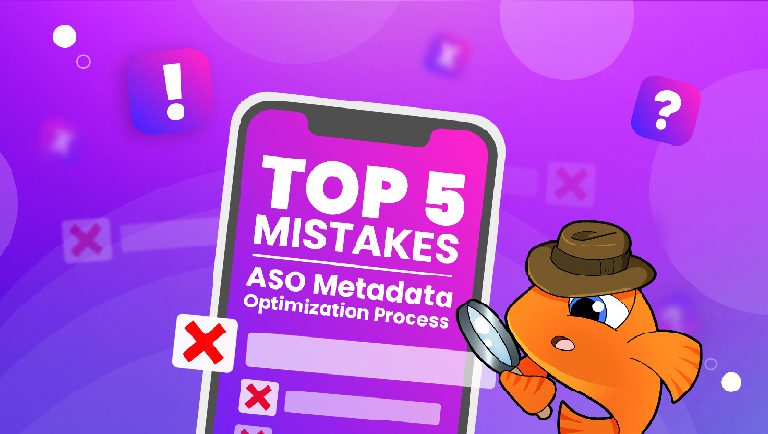
Top 5 Mistakes to Avoid During Your ASO Metadata Optimization Process
03.04.2024
•
5 mins read
Top 5 Mistakes to Avoid During Your ASO Metadata Optimization Process
Anna Frangogianni, Game Growth BD Manager | Yodo1
Table of Contents:
- Keyword Duplication in Metadata Fields
- Underutilizing Your Metadata Fields
- Using Low-performing Keywords
- Discrepancy Between Metadata and Visual Assets
- Neglecting Market and Competitor Research
For game developers, a clear and properly implemented ASO strategy can make or break a game’s organic success. I would go further and say that ASO is integral to any well-planned, comprehensive user acquisition strategy. While many factors can contribute to a winning ASO strategy, metadata optimization stands out for its direct impact on app visibility and discoverability.
Here are the top five mistakes to avoid during your metadata optimization process:
1. Keyword Duplication in Metadata Fields on the Apple App Store
One of the most common mistakes is duplicating keywords across metadata fields, such as the title, subtitle, and keywords field on the Apple App Store. Duplications in these fields will do nothing for your app's visibility; rather, they waste precious space that could be used to incorporate additional, high-volume keywords.
On the other hand, duplicating keywords in your long description on Google Play can boost discoverability, if done correctly.
Tip: For the long description in Google Play, aim for a keyword density of between 2-3%. This is calculated by taking the number of times a focus keyword is used in the long description divided by the total number of keywords in the long description x 100.
Example: Look at the keyword density of Idle Miner Tycoon: Gold & Cash. Strategic keywords like “idle” and “tycoon” fall within the ideal range within the long description.
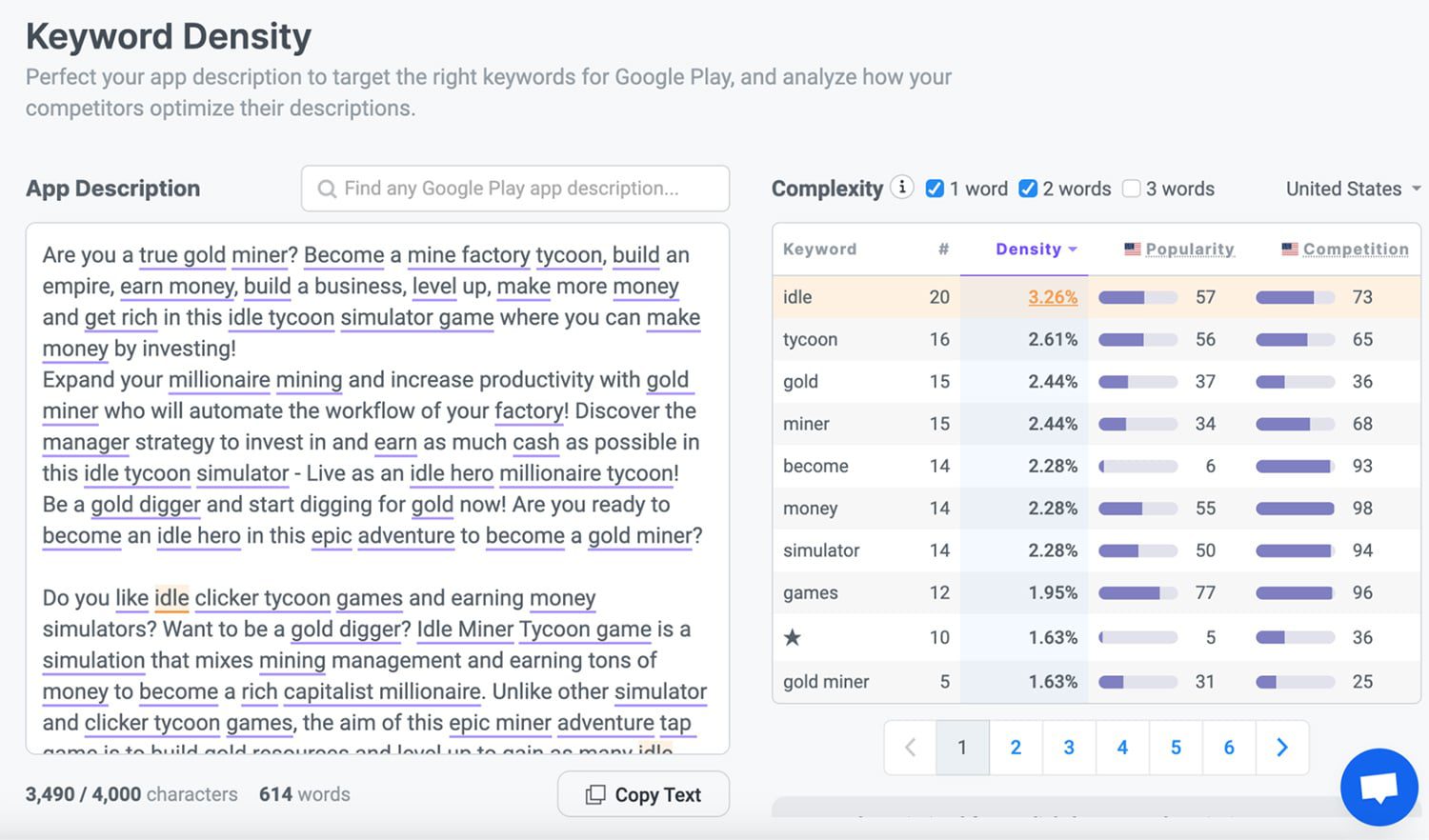
2. Underutilizing Your Metadata Fields
You get 30 characters for your title and subtitle fields and 100 characters in the hidden metadata field on the Apple App Store. Use them! Otherwise, you’re missing the chance to use valuable keywords in the fields that are visible in search and browse pages, as well as discoverable by users casually searching the stores for games similar to yours. It is also important to be aware that visible metadata fields carry more weight in the Apple App Store’s algorithm than the hidden metadata field.
Things are a little different on the Google Play side, as the algorithm is centered around keyword densities. What does that mean? Developers need to strategically use keywords across all their metadata fields (Title - 30 characters, Short Description - 80 characters, and Long Description - 4,000 characters) by finding a balance between the keywords they want to target and messaging that makes sense. Concise sentences/statements, especially in the short and long description fields, can actually perform better than longer entries—so be strategic and A/B test with Google’s native tools, and by all means, avoid keyword stuffing!
Note: A newer game might benefit from a more focused keyword strategy so that it can gain more weight in the algorithms. Expanding keyword usage to capture a broader audience becomes more important as the game gains traction.
3. Using Low-performing Keywords
Targeting the right keywords is a balancing act between search volume, difficulty scores, and relevance. Opting for keywords solely based on your brand or those with low search popularity can cause you to miss out on significant traffic. Aiming for a mix of short and long-tail keywords that promise high traffic and relevance to your game's content is important.
4. Discrepancy Between Metadata and Visual Assets
People scrolling through app stores tend to have a very short attention span. Usually, if they land on your game’s page, they have a purpose: to decide if the game is worth downloading! So, your visual metadata (the CTAs in your screenshots) must be clear, easy to read, and aligned with the search terms and keywords they used to find your game in the first place.
Example: Look at Idle Mafia’s use of “idle” in the second screenshot.

5. Neglecting Market and Competitor Research
Any solid ASO strategy should be grounded in comprehensive market and competitor analysis. Without this foundation, you risk overlooking key opportunities and challenges within your game's niche.
Do what the top developers and publishers do: collect an exhaustive list of keywords that represent the core and marginal users you want to target, and then prioritize them based on the following scores:
- Difficulty
- Popularity
- Relevance to the game
- Search ads conversion
Note: It is common for newer games to get less traffic using keywords with high popularity scores since larger games with bigger audiences (that are also promoted by the algorithm) tend to aim for these keywords as well. This is where strategic UA comes in to support your organic strategy once you start getting more traffic.
Final Thoughts
Avoiding these common mistakes in metadata optimization can dramatically improve your game's overall ASO performance. By strategically selecting and applying keywords, aligning your visual and text metadata, and grounding your efforts in thorough research, you can improve your app's discoverability and appeal to a wider audience, driving downloads and engagement.
To learn more about how your game can bring in more players, more revenue, and scale faster, apply for Yodo1’s Growth Accelerator Program.
Latest Blog Posts


Bumblebee joins the battle for a second Puzzles & Survival x Transformers event


Viking Rise x Vikings: Valhalla Event 4 – The Grand Finale of an Epic IP Saga


Wing Fighter x TRANSFORMERS – A Battle for the Ages!


Dragonheir: Silent Gods x Dungeons & Dragons – Enter the Third Phase of Epic Collaboration!


TRANSFORMERS bots and Puzzles & Survival Game Unite to Combat a Massive Invasion!


Yodo1 Gathers China’s Top Mobile Gaming Leaders to Explore Global Brand Partnerships in 2025
Game Growth
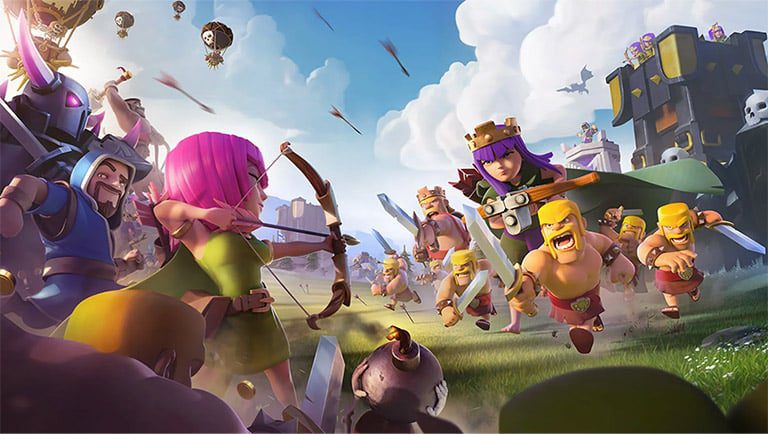
How Clash of Clans Makes Hundreds of Millions from IAPs
06.03.2024
•
5 mins read
How Clash of Clans Makes Hundreds of Millions from IAPs
In-app purchases (IAPs) are the lifeblood of sustainable revenue for any mobile game monetization strategy. But more than that, when implemented strategically, IAPs can create a win-win scenario for both developers and players.
The key is in striking a delicate balance. Players need to perceive value in what they purchase, whether it's special items, aesthetic customizations, in-game currency, etc. However, they shouldn’t feel that they are in a pay-to-win scenario that impacts the core game loop. If you can achieve this balance, players are more likely to spend – and keep spending. Of course, getting there is easier said than done. Finding the right IAP strategy for each game requires a deep understanding of player motivations and a data-driven approach.
A great example to learn from is Clash of Clans. This game has nailed its IAP mobile game monetization strategy. In this article, we will explore how they do it and what we can learn from them. But first, let's go over some of the basics.

Metrics that Matter:
If you cannot measure it, you cannot improve it,” said the wise Lord Kelvin. And while he wasn’t a game developer (that we know of), he had the right idea! Here are some key metrics to track and analyze:
- Average Revenue Per User (ARPU): Measures the average amount of money generated by each player, indicating the overall profitability of your IAP strategy.
- Conversion Rate: The percentage of players who purchase out of the total player base, highlighting the effectiveness of your IAP integration and visibility.
- Lifetime Value (LTV): Estimates the total revenue a player will generate throughout their engagement with the game, guiding long-term retention strategies.
- Purchase Frequency: Tracks how often players buy IAPs, aiding in optimizing the timing for promotional offers and new item releases.
- Retention Rate Post-Purchase: Assesses how making a purchase affects player retention, indicating the impact of IAPs on long-term engagement.
Player Motivation:
Players spend for a few different reasons. Apart from understanding these reasons, you should factor in value for money, and getting to the right price point for each IAP. Spending time understanding player motivation isn’t simply an intellectual exercise–it’s a crucial part of the process. Let’s briefly touch on these.
- Desire to Purchase: Identifying what drives players to spend is very important. Is it to gain a competitive edge, to express themselves, to improve the overall gaming experience? Understanding these motivations can help you create IAPs they will respond to.
- Value for Money: Players need to feel they're getting their money's worth. Diverse pricing bundles can cater to different player types, from those looking for a slight edge to those willing to invest more.
- Price Elasticity: Experimenting with price points through A/B testing will help you find the sweet spot where you’re maximizing revenue and making players happy. Adjust based on player feedback and purchasing behavior, aiming to create a win-win for you and your players.
Consumables vs. Non-Consumables:
- Consumable IAPs: Consumable IAPs (like game currency or boosts) should enhance the game but not be necessary to progress. This can help avoid pay-to-win scenarios.
- Non-Consumable IAPs: Non-consumable IAPs (like skins) add a personal touch and don't affect the game's balance. They generally emphasize style and personal expression or gaining in-game clout.
By always validating and updating your strategies based on what players say and how they act, you can find the best ways to price your in-game items. The main goal is to make players feel good about buying, not just once but over and over.
Clash of Clans: A Playbook for IAPs
Clash of Clans made $482 million in IAP revenue in 2022, with over 1.8 million daily active users (second only to Subway Surfers). Holy cow! The goal, then, is to reverse-engineer their success and see what insights we can uncover. As we go, think about how you might apply what you learn to your own IAP strategy. Let’s begin!
1. Balancing Consumables and Non-Consumables:
Gems: The quintessential consumable, gems fuel faster construction and troop training. For impatient players eager to climb the ranks, they're invaluable. Yet, Clash of Clans ensures progress remains attainable, albeit slower, for free-to-play users, preventing pay-to-win scenarios.
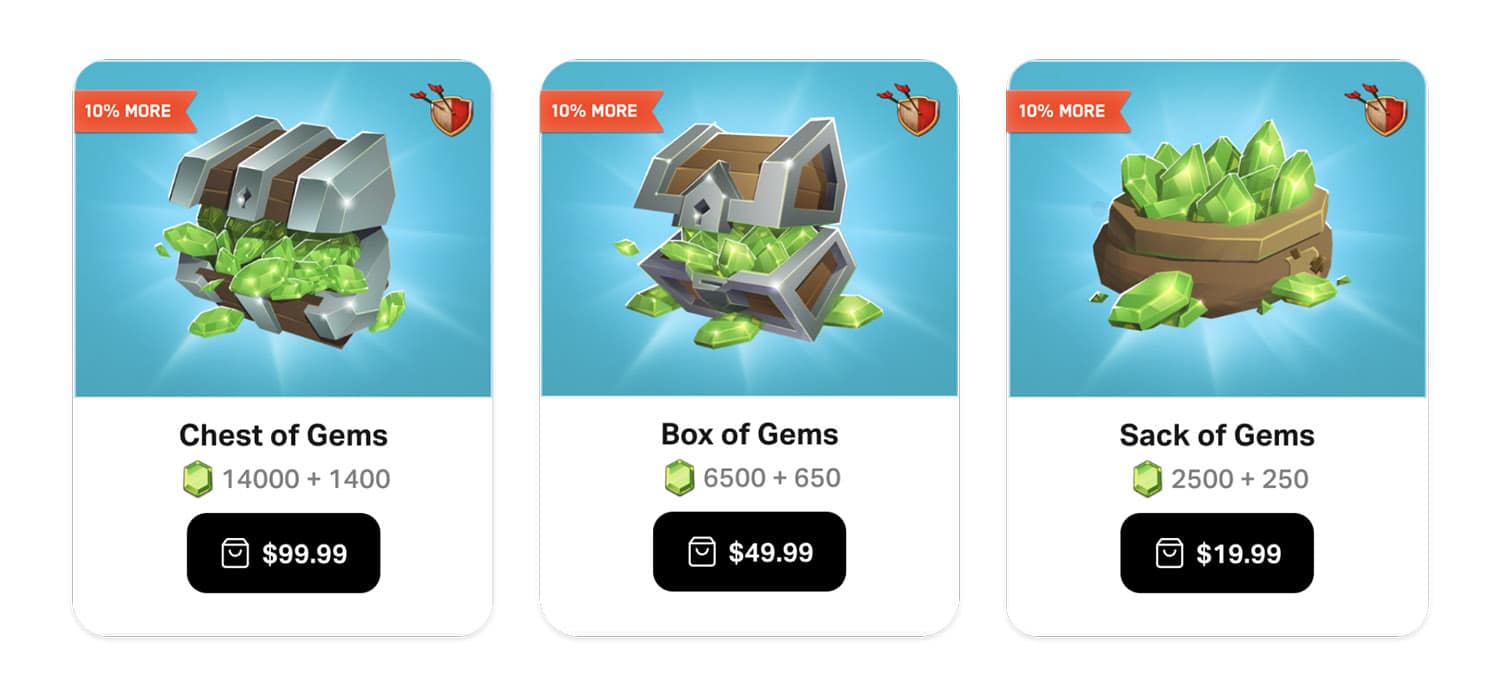
Hero Skins and Decorations: These non-consumables add a layer of personalization, letting players flaunt their individuality and dedication. The "Pumpkin Barbarian" or the "Crystal Queen Archer" don't impact gameplay but fuel emotional investment, encouraging long-term engagement. Games like Fortnite also put this principle at the core of their monetization strategy.
2. Understanding Player Demographics:
Hardcore Players: The Gold Pass, a monthly subscription offering exclusive rewards and bonus resources, targets those players seeking an edge. Its success shows Clash of Clans understands the premium placed on time optimization by dedicated players.
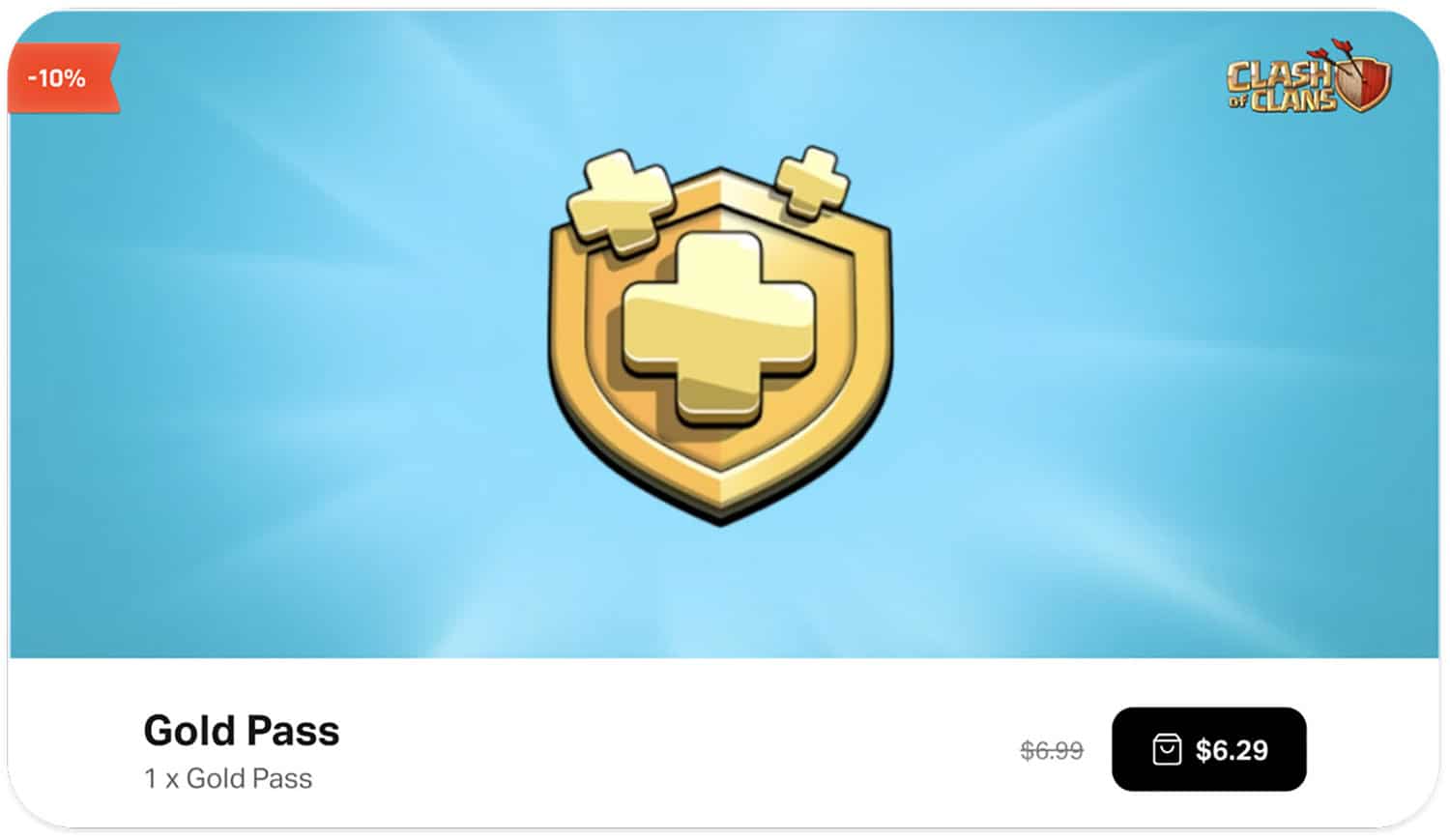
Casual Players: Limited-time offers and visually appealing bundles featuring discounted gems or resources cater to casual spenders who crave occasional boosts or want to catch up with friends. The "Builder Potion” or the "Cyber Special Bundle" offer instant gratification at an attractive price point.
3. A/B Testing and Iteration:
Clash of Clans constantly tweaks its IAPs based on data and player feedback. For instance, it introduced the "Seasonal Bank", a tiered reward system for active players, after testing different reward structures and price points. This data-driven approach ensures their IAPs remain relevant and enticing.
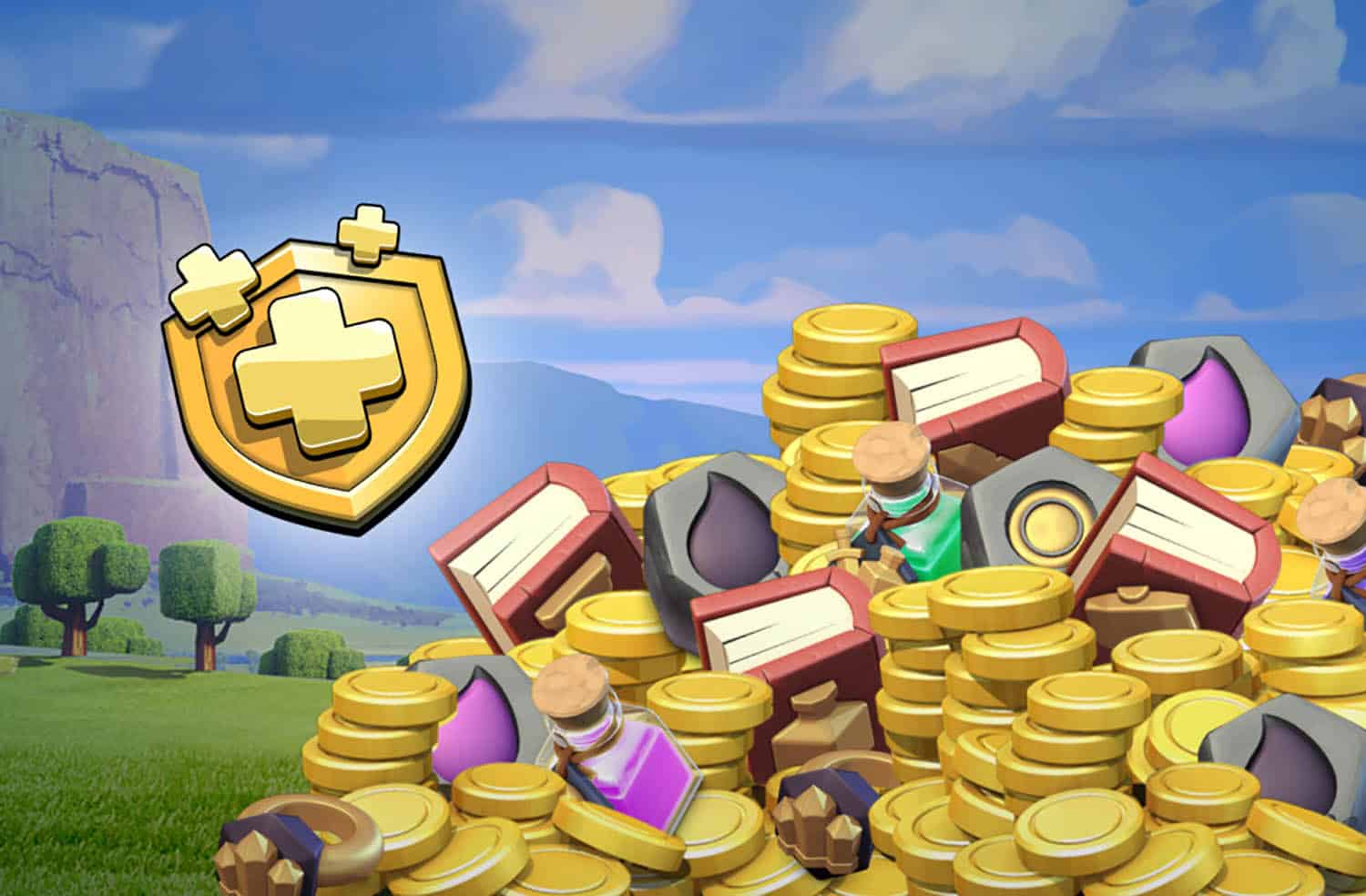
Key Takeaways
Clash of Clans is a textbook example of how to implement IAPs without compromising the player experience or the core game loop. Its success emphasizes the importance of:
- Variety: Offering a balanced mix of consumable and non-consumable IAPs appeals to diverse player motivations.
- Targeted Pricing: Tailoring IAPs to specific player segments, like the Gold Pass for hardcore players, maximizes revenue potential.
- No Pay-To-Win: Creating a compelling gameplay loop that incentivizes, but doesn't force, spending.
- Limited-Time Offers: Creating a sense of urgency with temporary deals encourages impulse purchases and keeps players engaged.
- Data-Driven Optimization: Constantly testing and iterating based on player behavior and feedback ensures IAPs remain effective.
- Player Psychology: Understanding player motivations (factoring in demographics) and tailoring IAPs accordingly.
- Data, Data, Data: Leveraging data and player feedback to constantly iterate and optimize.
It’s also important to note that Clash of Clans doesn't rely solely on IAPs for engagement. Regular content updates, clan wars, and seasonal events keep players hooked and incentivize spending. This holistic approach creates a vibrant ecosystem where IAPs feel like natural extensions of the gameplay experience, rather than intrusive monetization tactics.
By following these principles and analyzing the strategies of games like Clash of Clans, mobile game developers can unlock the true potential of their IAPs, building sustainable businesses while keeping players happy and engaged.
Remember, it's all about finding that sweet spot where player satisfaction meets profitability. For mobile games, the optimization of IAPs is a continuous journey. At Yodo1, we partner with game developers to hone their mobile game monetization strategies, bring in more players with tailored game growth strategies, and ultimately scale their games to new levels. And we do it well, with over 10 years of experience and over 3 billion downloads across our games. Check out Yodo1’s Growth Accelerator Program to learn about all the ways we help games grow.
Latest Blog Posts


Bumblebee joins the battle for a second Puzzles & Survival x Transformers event


Viking Rise x Vikings: Valhalla Event 4 – The Grand Finale of an Epic IP Saga


Wing Fighter x TRANSFORMERS – A Battle for the Ages!


Dragonheir: Silent Gods x Dungeons & Dragons – Enter the Third Phase of Epic Collaboration!


TRANSFORMERS bots and Puzzles & Survival Game Unite to Combat a Massive Invasion!


Yodo1 Gathers China’s Top Mobile Gaming Leaders to Explore Global Brand Partnerships in 2025
IP Licensing

The Upcoming Live-Action Zelda Film Marks Nintendo's Strategic Expansion
24.01.2024
•
5 mins read
The Upcoming Live-Action Zelda Film Marks Nintendo's Strategic Expansion
Ismael Jorge, BD Manager for Global Games at Yodo1
On the heels of a successful Mario movie, and after months of speculation, Nintendo has at last confirmed that a live-action Zelda movie is coming. Of course, it has opened the floodgates for speculation but also raises an interesting conversation about the future of brand staying power and the blurring of lines between games and Hollywood. In my experience helping bring mobile games and big IPs together, it's clear that translating gaming experiences to the big screen is a move loaded with potential – and pitfalls.

Via Nintendo
Strong Indicators of Success
Let's dig into the mechanics of this partnership. Nintendo's choice to bring Shigeru Miyamoto on board is a move that promises authenticity for the franchise. Partnering with a heavyweight like Avi Arad suggests a blend of storytelling that could capture the hearts of fans and newcomers alike. Here are a few key elements that I see working in the project’s favor:
- Miyamoto's Vision: As Zelda’s creator, he knows the characters and the universe inside out. His involvement is like a seal of quality for fans. A good proxy for this might be the hands-on oversight role Eiichiro Oda took on in the development of the live-action Netflix One Piece series, arguably the best live-action anime adaptation of all time – “Goda” be praised.
- Arad's Expertise: With a résumé full of Marvel's finest, Arad knows how to turn a beloved series into box office gold.
- Financial Backing: Sony and Nintendo are splitting the bill, which means they're both betting big on Zelda's success. Both have skin in the game, and reputations to protect. That could be a good indication, especially for Nintendo, who has been very cautious with movie projects over the years.
The choice between live-action and animation is a hot topic in fan circles, but it seems the ultimate decision came down to Miyamoto’s vision for the project, saying on Twitter, “I have asked Avi-san to produce this film with me, and we have now officially started the development of the film with Nintendo itself heavily involved in the production.”
I have asked Avi-san to produce this film with me, and we have now officially started the development of the film with Nintendo itself heavily involved in the production. It will take time until its completion, but I hope you look forward to seeing it. [2]https://t.co/2H9lzzS5Pv
— 任天堂株式会社 (@Nintendo) November 7, 2023
Casting decisions and plot direction are under lock and key, but the rumor mill is in full swing; with names like Hunter Schafer already linked to the project. There is speculation about Tom Holland as well, given his previous collaborations with Avi Arad on Uncharted and the Spiderman films.
A Strategic Expansion for Nintendo
Nintendo's move to adapt one of its most iconic games into a movie speaks to a broader strategy – capturing hearts beyond the console. With the success of other game-to-movie adaptations paving the way, Nintendo is poised to cast its net over the massive ocean of potential fans and I think it’s important to understand the broader strategy behind big bets like this.
- Broader Audience Reach: Nintendo is aiming to captivate not just gamers but “Zelda fans” more broadly. It’s one example of a much larger trend happening among major IP holders; it’s all about connecting with the fanbase and staying top-of-mind.
- New Market Opportunities: Movie and TV adaptations open up fresh avenues for merchandising and cross-promotion. One need only look to the 1.4x increase in year-on-year sales of Mario game titles to understand the massive economic halo effect an IP-driven movie release can create.
- Brand staying power: By expanding its IP to new mediums, Nintendo reinforces its place as a cultural powerhouse. A big part of Nintendo’s success is in its ability to continually renew and reinforce nostalgia among fans through fresh titles that feature iconic characters, be it in a new game, on a new platform, or in films. Nintendo adapts.
https://www.youtube.com/embed/n9_nOA3Md_c?si=xLRrnRnXhoecpsd5
Looking Ahead: The Zelda Movie and Beyond
The Zelda live-action movie is more than a new venture for Nintendo; it's a signal to all of us in the industry that the lines between games and other media are blurring. Nintendo's approach shows a keen understanding of the importance of storytelling and character development, something that any successful mobile game developer must appreciate.
Nintendo's expansion into live-action movies with Zelda is not just an exciting development to watch—it's a playbook for IP-based games. As we await more details on the Zelda movie, one thing is clear: the potential for mobile games to step beyond the small screen has never been greater.
Latest Blog Posts


Bumblebee joins the battle for a second Puzzles & Survival x Transformers event


Viking Rise x Vikings: Valhalla Event 4 – The Grand Finale of an Epic IP Saga


Wing Fighter x TRANSFORMERS – A Battle for the Ages!


Dragonheir: Silent Gods x Dungeons & Dragons – Enter the Third Phase of Epic Collaboration!


TRANSFORMERS bots and Puzzles & Survival Game Unite to Combat a Massive Invasion!


Yodo1 Gathers China’s Top Mobile Gaming Leaders to Explore Global Brand Partnerships in 2025
Game Growth

Game Growth Strategies: Boosting Your Game Globally with Strategic Localization
18.01.2024
•
5 mins read
Game Growth Strategies: Boosting Your Game Globally with Strategic Localization
So you built a game, launched it into the world, and it’s thriving! You’re monitoring and updating it, players are enthusiastic and your community is growing. That’s amazing! But you believe your game can go even further. So what comes next? Well, maybe it’s time for strategic localization. This can be a powerful way to increase the reach of your game, build global communities, boost retention, and ultimately create your own luck when it comes to game growth.
Don’t take our word for it. According to App Annie, 50% of the top 10 countries for downloads and revenue in the App Store are non-English speaking, predominantly from Europe and East Asia, and it’s even more for Google Play.
In this article, we will explore different sides of localization as a game growth strategy, and provide practical tips for how you can reach a global audience of players without breaking the bank. Let’s dive in!
What is Localization?
Going global with your game means speaking the language of your audience, literally. It's about expanding your player base and boosting player retention and long-term engagement by understanding the motivations, preferences, and cultural uniqueness of your potential players around the world. This involves tailoring your game's content, marketing materials, store listings, and overall messaging to resonate with specific demographics and regions.
But where do you begin? Well, let’s get into it! We’ve got practical suggestions and case studies to show what steps to take, how they work, and why they are important.
Pillar 1: Game Translation
Translation might be the most obvious part of localization, but there’s more to it than you might think. If you do a simple translation, even if the result seems natural (to you!), are you capturing the nuances? Connotations don't translate easily across languages. Your task is to craft a cohesive gaming experience that is extra-welcoming to players from a particular region.
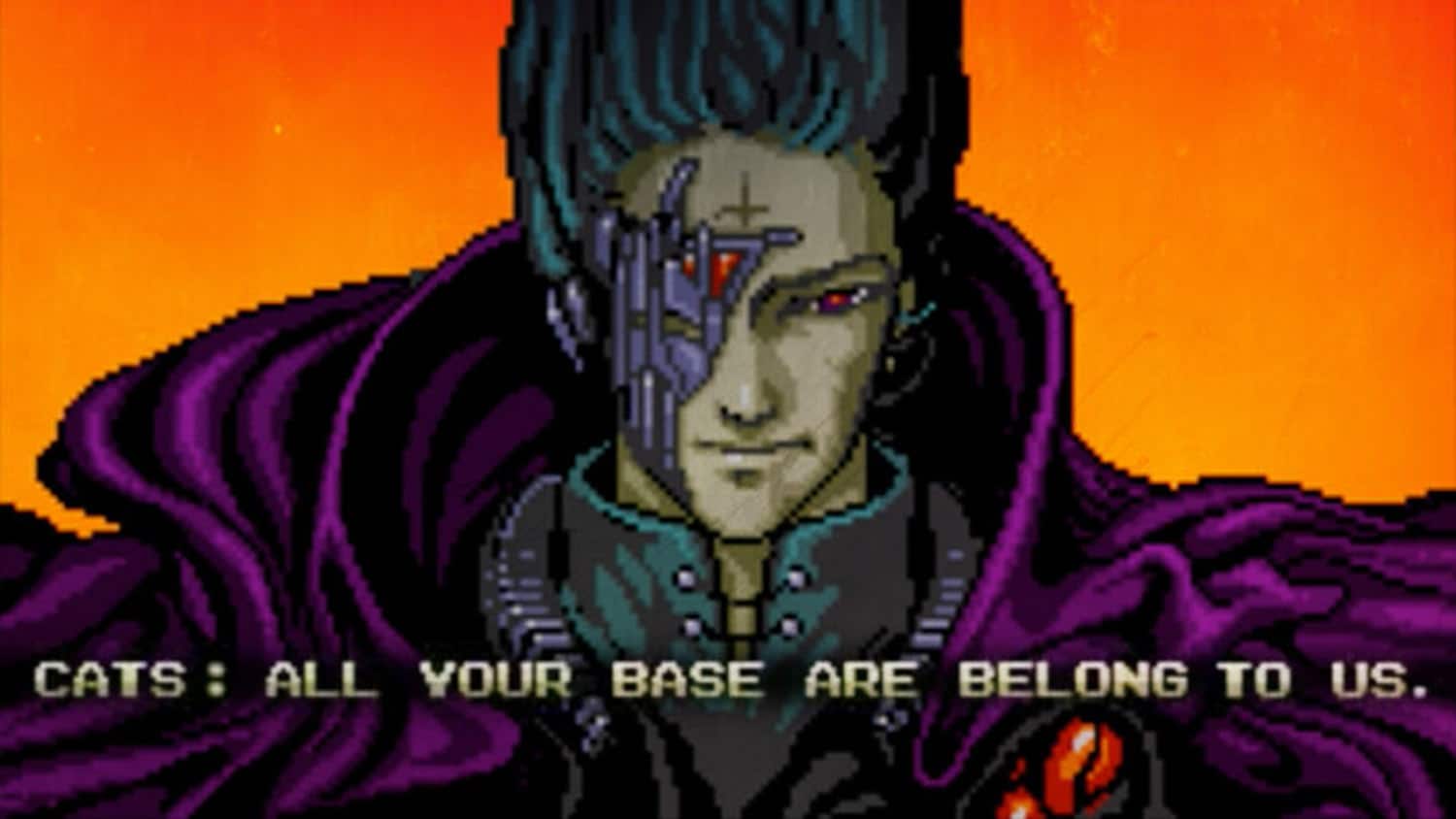
At Yodo1, we’ve found a keyword-focused approach to translation to be the most successful–at least initially. Translating a whole game is generally time and resource-intensive, so dip your toes in with keywords and go from there (as time and resources allow). Do keyword research in tools like Semrush or App Radar in your target language just as you would for your English store listing, and then, test! For example, maybe you want to localize your fantasy game for the German market. You may find that the term 'Zauberer' (Wizard) resonates more deeply with players than 'Magier' (Mage), despite their similar meanings in the game's context.
You need to identify those magic keywords (through A/B testing) that will connect with prospective players, but if you don’t know enough about the region in question, consider hiring a freelancer from the target country via Fiverr or Upwork to fine-tune your keywords and make sure they resonate from a local perspective. You could also consider reaching out directly to some of the players in your community to ask for input and refine your region-specific messaging. You may also consider crowdsourcing translations in your player community, as games like Idle Slayer have done, to great success.
Even in countries that speak the same language—like Portugal and Brazil, for example—you’ll find a lot of subtle differences, especially when it comes to colloquial terms or slang. Authenticity in the little things can make a difference, so make sure you give this the attention it needs.
Pillar 2: In-game Content Localization
While translating parts of your game is a good start, that's not even scratching the surface. Creating unique content for specific regions can show players that you understand their culture and genuinely care about them, which helps build strong bonds and can foster community. When you have that bond, players are likely to stick around longer. Yes, it boosts retention, which is a key component of a game’s overall success long term.
That’s why content localization is the second pillar of effective game localization. Put simply, it’s taking adaptation to another level by crafting experiences that incorporate specific cultural and regional elements.
“Well yes, that sounds great,” you may be thinking, “but how?”
Two primary approaches can work magic here.
The first approach is adding relevant in-game cultural content, and adapting parts of the game to highlight important elements in specific cultures and regions. You’ve already been analyzing your game’s market performance data (right?), so you can make informed decisions about which areas to invest your time and resources in to give you the best odds of success, whether that’s an increase in downloads, higher retention, etc.
Here at Yodo1, we’ve successfully used cultural events like Chinese New Year, for example, to craft specific in-game events and content for our game Rodeo Stampede, and it always results in exceptional player engagement. Players are drawn not just to the fun gameplay, but also to the sense of community and local connection as virtual celebrations overlap with real ones. This is where you really get to exercise your creativity!

The second approach that can really pay off is collaborations with local content creators; after all, they already know their audience and often wield significant influence within their regions. By partnering with them, you can tap into their unique insights and work together to create game-related content that local/native players will love.
Integrating localized content is not just about adapting the game; it's about creating an authentic and personalized gaming journey, bridging the cultural divide, and forging strong connections with global audiences. But how does this work in the real world?
Case Study: Crossy Road in South Korea
In 2015, the development team behind Crossy Road tapped into the power of tailored localization after noticing an organic surge in the game’s popularity in South Korea. Crucially, they were quick to react to the opportunity, creating an exclusive update designed specifically for South Korean gamers, incorporating cultural elements and familiar references.
In this case, the South Korean update introduced 10 new characters, including one inspired by the iconic K-Pop star, Psy, who quickly became an in-game favorite–he even recorded all his in-game sounds!
https://www.youtube.com/embed/3b4bZKfVIQw?si=JY2BKqE0ZTyZPAuF
And the game's localization efforts didn't stop there.
After members of the mega-boyband BTS mentioned the game on Twitter, the Crossy Road team was again quick to capitalize on it. They sent plush toys modeled after the game's beloved chickens to the group, who then shared these gifts on their Twitter accounts, further boosting the game’s reach.
The result? Crossy Road stayed at the number 1 download spot in the Google Play charts in South Korea for nearly 50 days!
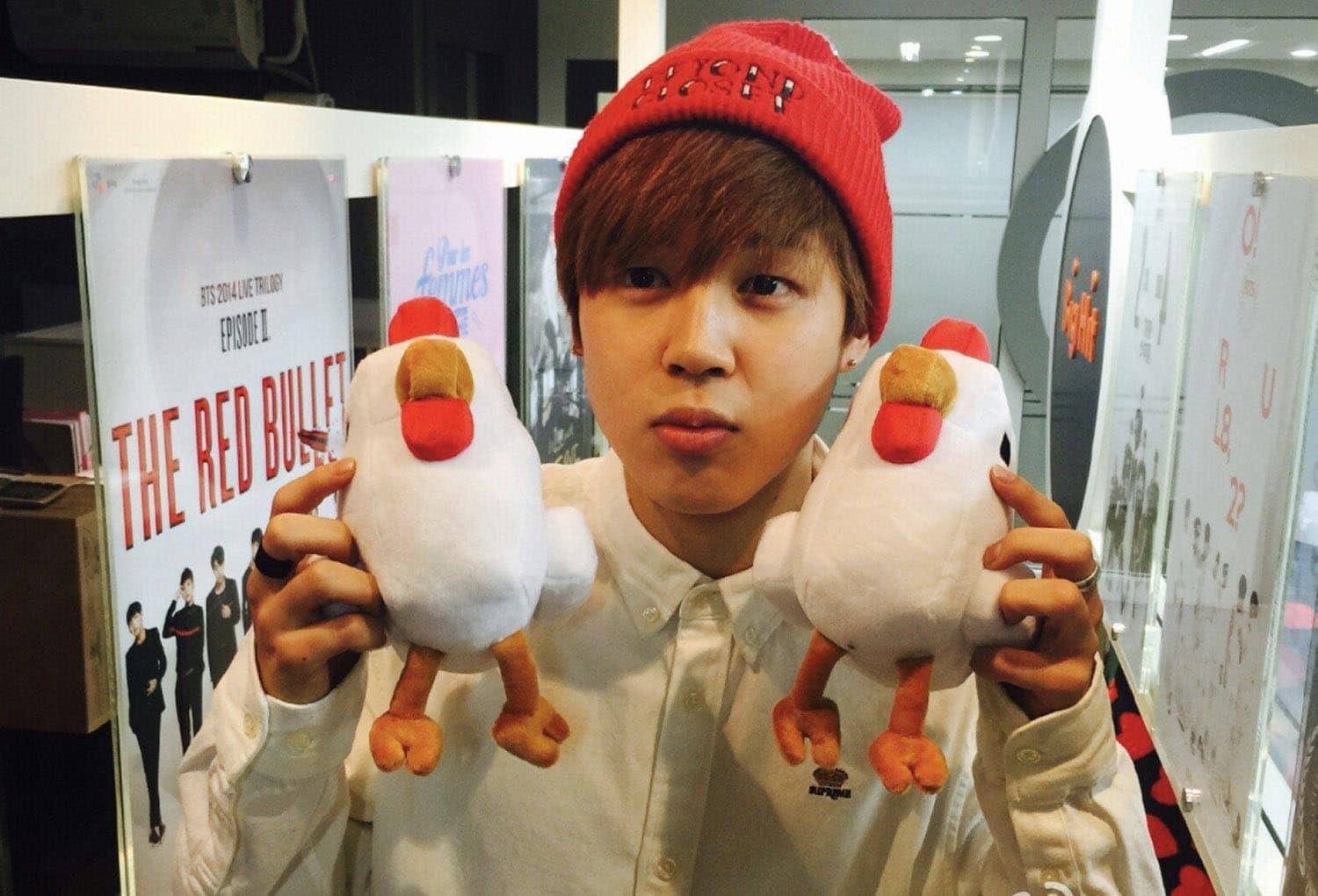
What can we learn from Crossy Road’s successful strategy?
- Tailored localization can have a profound impact on player engagement and community bonding
- Introducing culturally relevant content in games makes players feel valued and understood, and investing in these elements can amplify a game's appeal and foster strong connections in the focus region.
- Monitoring trends so you can strike while the iron is hot can yield significant dividends—this success story started with an initial unexpected, organic boost. Allocating resources intelligently allowed the team to leverage existing trends and amplify what was already working, rather than trying to generate hype where none existed.
These few examples of how strategic localization can make a huge difference are just the tip of the iceberg. In today’s mobile gaming market, having an effective localization strategy can be the magic formula that helps you stand out from the crowd and take your game to the next level.
Localization Playbook
Localization that is smart, personalized, and above all strategic is key for developers who want to grow a game to its fullest potential. Putting in the effort needed in this area can make the difference between being a successful, regional hit–and a global one.
Here are a few actionable points to recap what we’ve covered above, and get you started on the right foot with your localization efforts.
Research before diving in: Before investing in full-scale localization, do your research and make sure you understand the market and potential audience.
Localize based on data: Prioritize localization in regions where your game already has traction or shows potential based on the data. Build on organic trends.
Use keyword analysis early: Before translating everything, use keyword analysis to identify which are most relevant to your game, and focus on those first.
Deepen cultural connections: When localizing, go beyond mere translation by incorporating cultural nuances, slang, and local trends. Add content related to local cultural events or holidays.
Collaborate with local influencers: Partner with regional content creators to help introduce and promote your game in their communities.
Stay alert to regional trends: Continue to monitor your game's performance by region, so you can respond quickly if you notice a sudden spike in a particular area, like the Crossy Road example in South Korea.
We believe that great games make the world a better and more joyful place, and that game developers are modern-day wizards. Well, sometimes even wizards can use a hand. To learn more about how Yodo1 helps game developers at every stage reach the next level of growth, check out our Game Growth Accelerator program.
Latest Blog Posts


Bumblebee joins the battle for a second Puzzles & Survival x Transformers event


Viking Rise x Vikings: Valhalla Event 4 – The Grand Finale of an Epic IP Saga


Wing Fighter x TRANSFORMERS – A Battle for the Ages!


Dragonheir: Silent Gods x Dungeons & Dragons – Enter the Third Phase of Epic Collaboration!


TRANSFORMERS bots and Puzzles & Survival Game Unite to Combat a Massive Invasion!


Yodo1 Gathers China’s Top Mobile Gaming Leaders to Explore Global Brand Partnerships in 2025
Get Updates From Yodo 1




